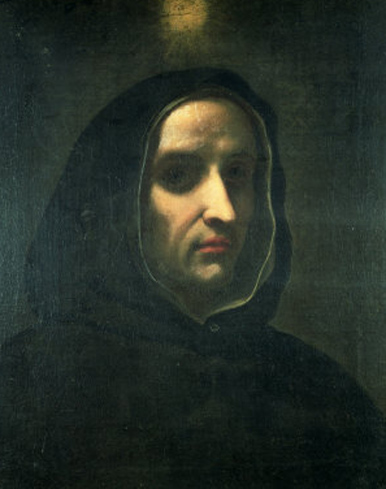
Fra Angelico
Italian Artist
1387 - 1455

Portrait of Fra Angelico
Fra Angelico born Guido di Pietro, was an Early Italian Renaissance painter, referred to in Vasari's Lives of the Artists as having "a rare and perfect talent".
Known in Italy as il Beato Angelico, he was known to his contemporaries as Fra Giovanni da Fiesole (Brother John from Fiesole). In Giorgio Vasari's Lives of the Artists, written prior to 1555, he was already known as Fra Giovanni Angelico (Brother Giovanni the Angelic One).
Within his lifetime or shortly thereafter he was also called Il Beato (the Blessed), in reference to his skills in painting religious subjects. In 1982 Pope John Paul II conferred beatification, in recognition of the holiness of his life, thereby making this title official. Fiesole is sometimes misinterpreted as being part of his formal name, but it was merely the name of the town where he took his vows, used by contemporaries to separate him from other Fra Giovannis. He is listed in the Roman Martyrology as Beatus Ioannes Faesulanus, cognomento Angelicus-"Blessed Giovanni of Fiesole, nicknamed Angelico".
The 16th century biographer Vasari says of him:
But it is impossible to bestow too much praise on this holy father, who was so humble
and modest in all that he did and said and whose pictures were painted with such
facility and piety.
Early life, 1395-1436
Fra Angelico was born Guido di Pietro at Rupecanina, in the Tuscan area of Mugello, near Fiesole towards the end of the 14th century and died in Rome in 1455. Nothing is known of his parents. He was baptized Guido or Guidolino. The earliest recorded document concerning Fra Angelico dates from October 17, 1417 when he joined a religious confraternity at the Carmine Church, still under the name of Guido di Pietro. This record also reveals that he was already a painter, a fact that is subsequently confirmed by two records of payment to Guido di Pietro in January and February 1418 for work done in the church of Santo Stefano del Ponte. The first record of Angelico as a friar dates from 1423, when he is first referred to as Fra Giovanni, following the custom of those entering a religious order of taking a new name. He was a member of the Dominican Community at Fiesole. Fra, an abbreviation of Frate (from the Latin Frater), is a conventional title for a friar or brother.
Fra Angelico initially received training as an illuminator, possibly working with his older brother Benedetto who was also a Dominican. His illumination tutor is unknown. San Marco in Florence holds several manuscripts that are thought to be entirely or partly by his hand. The painter Lorenzo Monaco may have contributed to his art training, and the influence of the Sienese School is discernible in his work. He had several important charges in the convents he lived in, but this did not limit his art, which very soon became famous. According to Vasari, the first paintings of this artist were an altarpiece and a painted screen for the Carthusian Monastery of Florence; none such exist there now.
From 1408 to 1418 Fra Angelico was at the Dominican friary of Cortona where he painted frescoes, now destroyed, in the Dominican Church and may have been assistant to or follower of Gherardo Starnina. Between 1418 and 1436 he was at the convent of Fiesole where he also executed a number of frescoes for the church, and the Altarpiece, deteriorated but restored. A predella of the Altarpiece remains intact in the National Gallery, London which is a superb example of Fra Angelico's ability. It shows Christ in Glory, surrounded by more than 250 figures, including beatified Dominicans.
Christ Glorified in the Court of Heaven

San Marco, Florence, 1436-1445
In 1436 Fra Angelico was one of a number of the friars from Fiesole who moved to the newly-built Friary of San Marco in Florence. This was an important move which put him in the centre of artistic activity of the region and brought about the patronage of one of the wealthiest and most powerful members of the city's Signoria, Cosimo de' Medici, who had a large cell (later occupied by Savonarola) reserved for himself at the friary in order that he might retreat from the world. It was, according to Vasari, at Cosimo's urging that Fra Angelico set about the task of decorating the monastery, including the magnificent Chapter House fresco, the often-reproduced Annunciation at the top of the stairs to the cells, the Maesta with Saints and the many smaller devotional frescoes depicting aspects of the Life of Christ that adorn the walls of each cell.
In 1439 he completed one of his most famous works, the Altarpiece for Saint Marco's, Florence. The result was unusual for its times. Images of the enthroned Madonna and Child surrounded by saints were common, but they usually depicted a setting that was clearly heaven like, in which saints and angels hovered about as divine presences rather than people. But in this instance, the saints stand squarely within the space, grouped in a natural way as if they were able to converse about the shared experience of witnessing the Virgin in glory. Paintings such as this, known as Sacred Conversations, were to become the major commissions of Giovanni Bellini, Perugino and Raphael.
The Vatican, 1445-1455
In 1445 Pope Eugenius IV summoned him to Rome to paint the frescoes of the Chapel of the Holy Sacrament at Saint Peter's, later demolished by Pope Paul III. Vasari claims that at this time Fra Angelico was offered by Pope Nicholas V the Archbishopric of Florence, and that he refused it, recommending another friar for the position. While the story seems possible and even likely, if Vasari's date is correct, then the pope must have been Eugenius and not Nicholas. In 1447 Fra Angelico was in Orvieto with his pupil, Benozzo Gozzoli, executing works for the Cathedral. Among his other pupils were Zanobi Strozzi.
From 1447 to 1449 he was back at the Vatican, designing the frescoes for the Niccoline Chapel for Nicholas V. The scenes from the lives of the two martyred deacons of the Early Christian Church, Saint Stephen and Saint Lawrence may have been executed wholly or in part by assistants. The small chapel, with its brightly frescoed walls and gold leaf decorations gives the impression of a jewel box. From 1449 until 1452, Fra Angelico was back at his old convent of Fiesole, where he was the Prior.
Death and Beatification
In 1455 Fra Angelico died while staying at a Dominican Convent in Rome, perhaps in order to work on Pope Nicholas' Chapel. He was buried in the church of Santa Maria sopra Minerva.
When singing my praise, don't liken my talents to those of Apelles.
Say, rather, that, in the name of Christ, I gave all I had to the poor.
The deeds that count on Earth are not the ones that count in Heaven.
I, Giovanni, am the flower of Tuscany.
~ Translation of Epitaph
Pope John Paul II beatified Fra Angelico on October 3, 1982 and in 1984 declared him patron of Catholic artists.
Angelico was reported to say "He who does Christ's work must stay with Christ always".
This motto earned him the epithet "Blessed Angelico", because of the perfect integrity
of his life and the almost divine beauty of the images he painted, to a superlative extent
those of the Blessed Virgin Mary.
Pope John Paul II
From various accounts of Fra Angelico's life, it is possible to gain some sense of why he
was deserving of canonization. He led the devout and ascetic life of a Dominican friar,
and never rose above that rank; he followed the dictates of the order in caring for the
poor; he was always good-humored. All of his many paintings were of divine subjects,
and it seems that he never altered or retouched them, perhaps from a religious
conviction that, because his paintings were divinely inspired, they should retain their
original form. He was wont to say that he who illustrates the acts of Christ should be
with Christ. It is averred that he never handled a brush without fervent prayer and he
wept when he painted a Crucifixion. The Last Judgment and the Annunciation were two
of the subjects he most frequently treated.
Background
Fra Angelico was working at a time when the style of painting was in a state of change. This process of change had begun a hundred years previous with the works of Giotto and several of his contemporaries, notably Giusto de' Menabuoi, both of whom had created their major works in Padua, although Giotto was trained in Florence by the great Gothic artist, Cimabue, and painted a fresco cycle of Saint Francis in the Bardi Chapel in Santa Croce. Giotto had many enthusiastic followers, who imitated his style in fresco, some of them, notably the Lorenzetti, achieving great success.
Patronage
The patrons of these artists were most often monastic establishments or wealthy families endowing a church. Because the paintings often had devotional purpose, the clients tended to be conservative. Frequently, it would seem, the wealthier the client, the more conservative the painting. There was a very good reason for this. The paintings that were commissioned made a statement about the patron. Thus the more gold leaf it displayed, the more it spoke to the patron's glory. The other valuable commodities in the paint-box were lapis lazuli and vermilion. Paint made from these colors did not lend itself to a tonal treatment. The azure blue made of powdered lapis lazuli went on flat, the depth and brilliance of color being, like the gold leaf, a sign of the patron's ability to provide well. For these reasons, altarpieces are often much more conservatively painted than frescoes, which were often of almost life-sized figures and relied upon a stage-set quality rather than lavish display in order to achieve effect.
Contemporaries
Fra Angelico was the contemporary of Gentile da Fabriano. Gentile's altarpiece of the Adoration of the Magi, 1423, in the Uffizi is regarded as one of the greatest works of the style known as International Gothic. At the time it was painted, another young artist, known as Masaccio, was working on the frescoes for the Brancacci Chapel at the Church of the Carmine. Masaccio had fully grasped the implications of the art of Giotto. Few painters in Florence saw his sturdy, life-like and emotional figures and were not affected by them. His work partner was an older painter, Masolino, of the same generation as Fra Angelico. Sadly Masaccio died at 27, leaving the work unfinished.
Altarpieces
The works of Fra Angelico reveal elements that are both conservatively Gothic and progressively Renaissance. In the altarpiece of the Coronation of the Virgin, painted for the Florentine Church of Santa Maria Novella, are all the elements that a very expensive altarpiece of the 14th century was expected to provide a precisely tooled gold background, lots of azure, lots of vermilion and an obvious display of arsenic green. The workmanship of the gilded haloes and gold-edged robes is exquisite and all very Gothic. What make this a Renaissance painting, as against Gentile da Fabriano's masterpiece, is the solidity, the three-dimensionality and naturalism of the figures and the realistic way in which their garments hang or drape around them. Even though it is clouds these figures stand upon, and not the earth, they do so with weight.
Frescoes
The series of frescoes that Fra Angelico painted for the Dominican friars at San' Marcos realize the advancements made by Masaccio and carry them further. Away from the constraints of wealthy clients and the limitations of panel painting, Fra Angelico was able to express his deep reverence for his God and his knowledge and love of humanity. The meditational frescoes in the cells of the convent have a quieting quality about them. They are humble works in simple colors. There is more mauvish-pink than there is red while the brilliant and expensive blue is almost totally lacking. In its place is dull green and the black and white of Dominican robes. There is nothing lavish, nothing to distract from the spiritual experiences of the humble people who are depicted within the frescoes. Each one has the effect of bringing an incident of the life of Christ into the presence of the viewer. They are like windows into a parallel world. These frescoes remain a powerful witness to the piety of the man who created them. Vasari relates that Cosimo de' Medici seeing these works, inspired Fra Angelico to create a large Crucifixion scene with many saints for the Chapter House. As with the other frescoes, the wealthy patronage did not influence the Friar's artistic expression with displays of wealth.
Masaccio ventured into perspective with his creation of a realistically painted niche at Santa Maria Novella. Subsequently, Fra Angelico demonstrated an understanding of linear perspective particularly in his Annunciation paintings set inside the sort of arcades that Michelozzo and Brunelleschi created at San' Marco's and the square in front of it.
Lives of the Saints
When Fra Angelico and his assistants went to the Vatican to decorate the chapel of Pope Nicholas, then the artist was again confronted with the need to please the very wealthiest of clients. In consequence, walking into the small chapel is like stepping into a jewel box. The walls are decked with the brilliance of color and gold that one sees in the most lavish creations of the Gothic painter Simone Martini at the Lower Church of Saint Francis of Assisi, a hundred years earlier. Yet Fra Angelico has succeeded in creating designs which continue to reveal his own preoccupation with humanity, with humility and with piety. The figures, in their lavish gilded robes, have the sweetness and gentleness for which his works are famous. According to Vasari:
In their bearing and expression, the saints painted by Fra Angelico come nearer to the
truth than the figures done by any other artist.
It is probable that much of the actual painting was done by his assistants to his design. Both Benozzo Gozzoli and Gentile da Fabriano were highly accomplished painters. Benozzo took his art further towards the fully developed Renaissance style with his expressive and life-like portraits in his masterpiece of the Journey of the Magi, painted in the Medici's private chapel at their palazzo.
Artistic Legacy
Through Fra Angelico's pupil Benozzo Gozzoli's careful portraiture and technical expertise in the art of fresco we see a link to Ghirlandaio, who in turn painted extensive schemes for the wealthy patrons of Florence, and through Ghirlandaio to his pupil Michelangelo and the High Renaissance.
Apart from the lineal connection, superficially there may seem little to link the humble priest with his sweetly pretty Madonnas and timeless Crucifixions to the dynamic expressions of Michelangelo's larger-than-life creations. But both these artists received their most important commissions from the wealthiest and most powerful of all patrons, the Vatican.
When Michelangelo took up the Sistine Chapel commission, he was working within a space that had already been extensively decorated by other artists. Around the walls the Life of Christ and Life of Moses were depicted by a range of artists including his teacher Ghirlandaio, Raphael's teacher Perugino and Botticelli. They were works of large scale and exactly the sort of lavish treatment to be expected in a Vatican commission, vying with each other in complexity of design, number of figures, elaboration of detail and skilful use of gold leaf. Above these works stood a row of painted Popes in brilliant brocades and gold tiaras. None of these splendors have any place in the work which Michelangelo created. Michelangelo, when asked by Pope Julius II to ornament the robes of the Apostles in the usual way, responded that they were very poor men.
Within the cells of San'Marco, Fra Angelico had demonstrated that painterly skill and the artist's personal interpretation were sufficient to create memorable works of art, without the expensive trappings of blue and gold. In the use of the unadorned fresco technique, the clear bright pastel colors, the careful arrangement of a few significant figures and the skilful use of expression, motion and gesture, Michelangelo showed himself to be the artistic descendant of Fra Angelico. Frederick Hartt describes Fra Angelico as "prophetic of the mysticism" of painters such as Rembrandt, El Greco and Zurbarán.
Quoted From: Fra Angelico - Wikipedia
Source: Art Renewal Center
Selected Works of Fra Angelico
from the Web Gallery of Art
Prado Altarpiece: (1430-32)
The altarpiece comes from the Church of San Domenico in Fiesole, it was sold and taken
to Spain in 1611. The main painting is the Annunciation which repeats a design Fra Angelico
also used in an Annunciation in Cortona and in another at the head of the stairs to the dormitory
of his monastery, San Marco in Florence. There are five small predella pictures below the Annunciation,
painted on the same panel, depicting the story of the Virgin.
The Annunciation: 1430-32
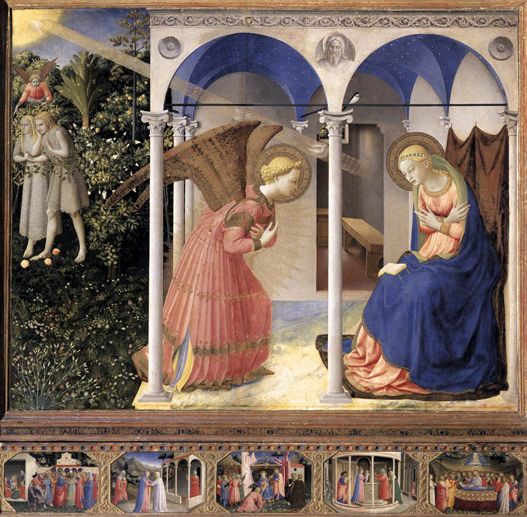
The Annunciation is the main painting on the altarpiece known as the Prado Altarpiece. There are five small predella pictures below the Annunciation, painted on the same panel, depicting the story of the Virgin. The altarpiece, and especially the predella paintings are of extremely high quality thus without any doubts they are the works of Fra Angelico. The central image repeats a design Fra Angelico also used in an Annunciation in Cortona and in another at the head of the stairs to the dormitory of his monastery, San Marco in Florence. The new Renaissance command of architectural perspective accompanies a continuing medieval delight in the lavish use of gilding.
The painting comes from the Church of San Domenico in Fiesole, it was sold and taken to Spain in 1611.
Quoted From: Web Gallery of Art - Fra Angelico
The Annunciation: 1430-32
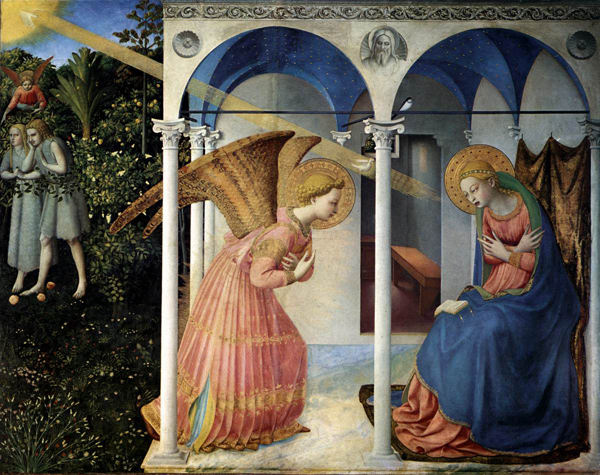
The Annunciation is the main painting on the altarpiece known as the Prado Altarpiece. The central image repeats a design Fra Angelico also used in an Annunciation in Cortona and in another at the head of the stairs to the dormitory of his monastery, San Marco in Florence. The new Renaissance command of architectural perspective accompanies a continuing medieval delight in the lavish use of gilding.
Quoted From: Web Gallery of Art - Fra Angelico
The Annunciation (Detail): 1430-32
_1430_32.jpg)
On the extreme left of the Annunciation scene is a patch of vegetation, where in the distance Adam and Eve are being sent out of Paradise by the angel. The meaning is clear: the coming of Christ as promised by the Annunciation will redeem the sin of the first children.
Quoted From: Web Gallery of Art - Fra Angelico
Last Judgement: (1432-35)
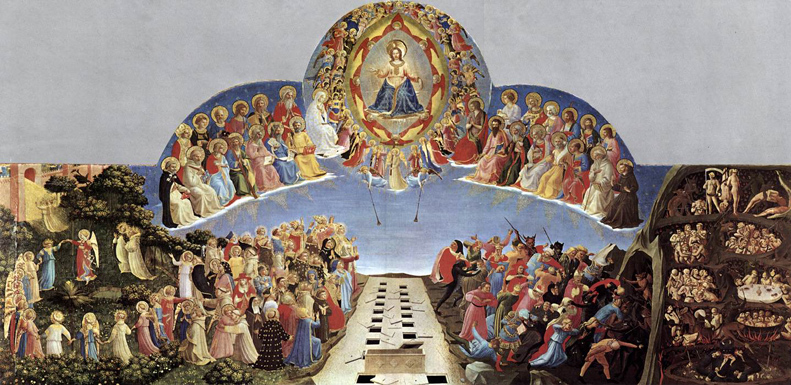
Originally in the Church of Santa Maria degli Angioli in Florence. Angelico is more easily recognized in the "Dance of Paradise" and in the saints, the Hell and the damned are by followers.
Quoted From: Web Gallery of Art - Fra Angelico
Last Judgment (Detail): 1432-35
_1432_35.jpg)
This is the left view of the panel.
Quoted From: Web Gallery of Art - Fra Angelico
Last Judgment (Detail): 1432-35
_1432_35_Two.jpg)
This detail is from the right side of the panel.
Quoted From: Web Gallery of Art - Fra Angelico
Last Judgment (Detail): 1432-35
_1432_35_Three.jpg)
The large receding rectangle of empty tombs creates the depth in the bottom half of this picture. An empty sarcophagus laid across it in the foreground subtly reduces the emphasis on this axis. Originally forming part of a seat, the complete picture extends to either side to show paradise and hell, but these scenes are thought to be by Angelico's workshop. Beside the empty tombs stand the judged; the saved with radiant heads exit left to paradise; and demons drive the nimbus-less damned to the right, down to hell.
In the upper part of the panel Christ sits in judgment in a mandorla framed by a border of angels. On his right is the Virgin and on his left Saint John the Baptist. Beyond them on each side are two tiers of seated apostles and saints. The spatial depth of the terrestrial part of the picture is not maintained in the celestial half, the slight angling of the two banks of saints failing to give heaven the same illusion of depth.
Quoted From: Web Gallery of Art - Fra Angelico
Last Judgment (Detail): 1432-35
_1432_35_Four.jpg)
The detail shows the Hell from the right side of the painting.
Quoted From: Web Gallery of Art - Fra Angelico
The Cortona Altarpiece: (The Annunciation, 1433-34)
This altarpiece, called Cortona Altarpiece (to be distinguished from the Cortona Triptych)
and consisting of the Annunciation and six small predella pictures, was executed for the church San Domenico at
Cortona, and in later centuries, probably during the French occupation, was transferred to the church Gesù,
presently the Museo Diocesano.
Annunciation: 1433-34
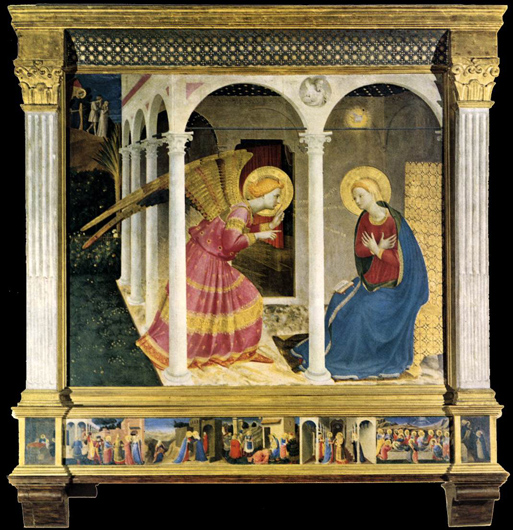
The painting is a repetition of the main panel of the Prado Altarpiece in a more refined architectural setting. The altarpiece is the work of Fra Angelico with an intervention of his collaborators only in the predella pictures.
Quoted From: Web Gallery of Art - Fra Angelico
Annunciation: 1433-34

In a loggia of columns and arches, the angel appears to Mary. Shown in profile, he occupies the larger part of the painting, his richly painted wings extending out through the colonnade, their upper tips marking the centre of the picture. He declaims to the Virgin, 'the Holy Ghost shall come upon thee, and the power of the highest shall overshadow thee' (Luke 1, v. 35). She, demure, with a dove fluttering above her head in a burst of golden light, inclines towards him and responds, 'Behold the handmaid of the Lord; be it unto me according to thy word' (Luke 1, v. 38). Beyond them the picture space extends into the Virgin's chamber, and further, hidden space is hinted at by the bed curtain there which serves also to set off Gabriel's nimbus.
Outside the loggia is a delicately painted garden, enclosed by a palisade, symbolic of Mary's virginity. Carved in a roundel above the centre column is a half-length effigy of Isaiah, who had prophesied the birth of a child to a virgin. The pink entablature of the loggia points to the second reference to the Old Testament, in the top left corner, where Adam and Eve are expelled from Paradise.
Undoubtedly Angelico's first truly great painting, this Annunciation formed a prototype for a noble line of derivatives.
Quoted From: Web Gallery of Art - Fra Angelico
Annunciation (Detail): 1433-34
_1433_34.jpg)
The picture shows the Angel of the Annunciation wearing precious garment embroidered with gold.
_1433_34_Two.jpg)
Quoted From: Web Gallery of Art - Fra Angelico
Birth of the Virgin: 1433-34
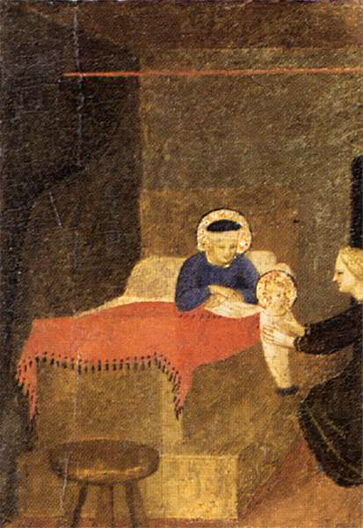
In the predella below the Annunciation, near the two farthest edges, two scenes are painted. The first represent the Birth of the Virgin, the other The Virgin Consigns the Habit to Saint Dominic. There are five central scenes of the life of the Virgin, one after the other without interruption, namely (from the left). Marriage of the Virgin, The Visitation, Adoration of the Magi, Presentation of Jesus at the Temple, Death of the Virgin.
This picture shows the scene of the Birth of the Virgin.
Quoted From: Web Gallery of Art - Fra Angelico
Marriage of the Virgin: 1433-34
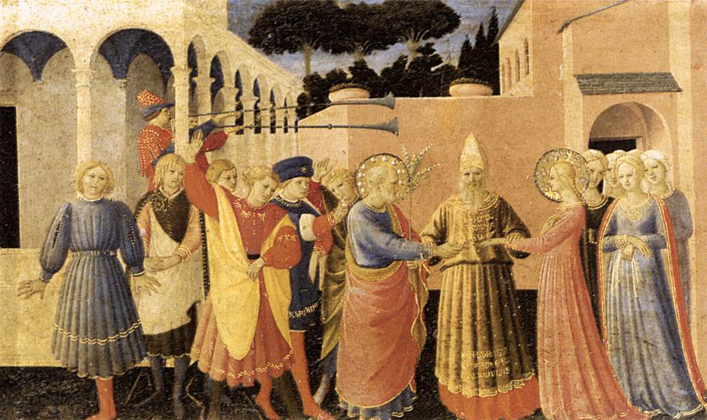
In the predella below the Annunciation, near the two farthest edges, two scenes are painted. The first represent the Birth of the Virgin, the other The Virgin Consigns the Habit to Saint Dominic. There are five central scenes of the life of the Virgin, one after the other without interruption, namely (from the left). Marriage of the Virgin, The Visitation, Adoration of the Magi, Presentation of Jesus at the Temple, Death of the Virgin.
This picture shows the scene of the Marriage of the Virgin.
Quoted From: Web Gallery of Art - Fra Angelico
Visitation: 1433-34
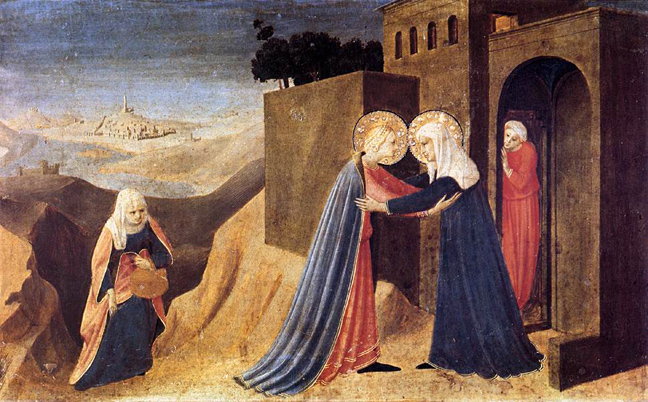
This picture shows the scene of the Visitation. The event shown here is described in the Gospel of Luke. Immediately following the Annunciation, Mary 'went into the hill country with haste, into a city of Juda; and entered into the house of Zacharias, and saluted Elisabeth' (Luke 1, v. 39-40). The Virgin and Elizabeth embrace, the straight folds of their gowns showing a simplicity and reserve alien to the curvilinear trecento influences of some of Angelico's mentors and contemporaries. Elizabeth, six months pregnant with John the Baptist, is given a wider girth than her cousin. Juda is represented by a series of simple, geometric forms, sharply lit but slightly thin and awkward. A woman makes her way up the hill path which lies in shadow below her. Behind her the sky and earth meet in the haze of a Tuscan summer.
This is the first identifiable landscape in Italian art. In the middle distance a lake, which no longer exists, spreads out in the Chiana Valley; beyond rises the town of Castigliona Florentino, and further distant the tower of Monterchi.
Quoted From: Web Gallery of Art - Fra Angelico
Adoration of the Magi: 1433-34

This picture shows the scene of The Adoration of the Magi.
Quoted From: Web Gallery of Art - Fra Angelico
The Presentation of Christ in the Temple: 1433-34
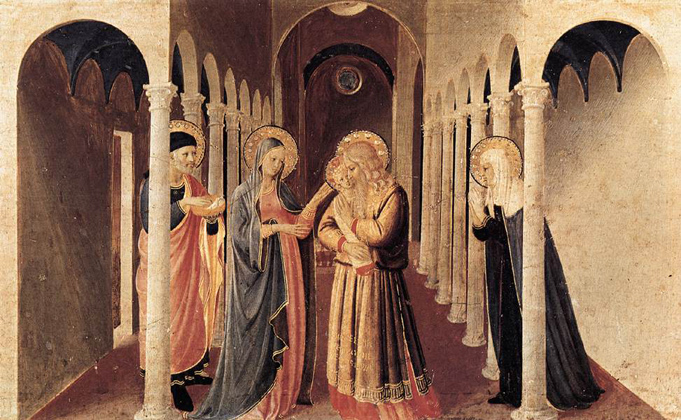
This picture shows the scene of the Presentation of Christ in the Temple. In this scene Joseph, the Virgin, the High Priest and Saint Anne stand in the foreground, a nave of receding columns extending backwards behind them. Exterior space is hinted at by the doorway to the left, the round window in the apse, the edge of the top light high above the nave and the strong light hitting the foreground from a source outside the picture space.
Quoted From: Web Gallery of Art - Fra Angelico
Death of the Virgin: 1433-34
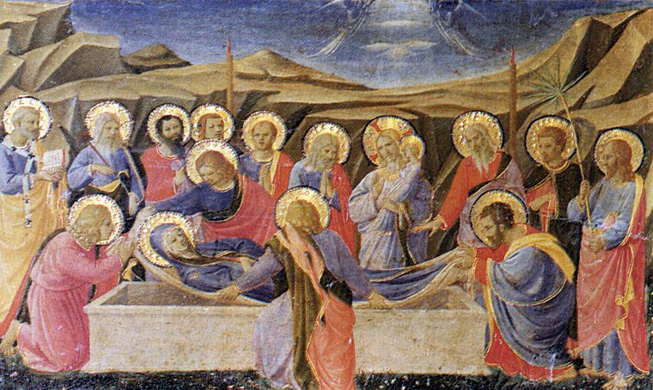
This picture shows the scene of Death of the Virgin.
Quoted From: Web Gallery of Art - Fra Angelico
The Virgin Consigns the Habit to Saint Dominic: 1433-34
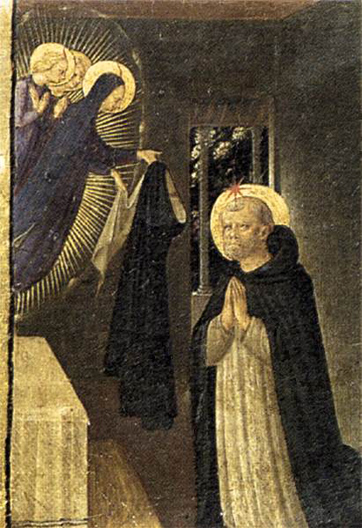
This picture shows the scene of 'The Virgin Consigns the Habit to Saint Dominic'.
Quoted From: Web Gallery of Art - Fra Angelico
Linaioli Tabernacle: (ca 1433)
The Arte de' Linaiuoli, the Guild of Linen Manufacturers, commissioned this altarpiece
from Angelico in 1432, for the Residenza of the Guild in the Piazza Sant' Andrea in Florence.
The mammoth frame, 520 cm high and 270 cm wide, was designed by Ghiberti and executed by three
craftsmen in his workshop. With closed shutters it represents the statuesque figures of Saint Mark and
Saint Peter, while with open doors the Virgin and Child Enthroned with Saint John the Baptist and
Saint Mark. The three predella pictures are the Predicament of Saint Peter, the Adoration of the Magi
and the Martyrdom of Saint Mark.
Linaioli Tabernacle (Shutters Closed): ca 1433
_ca_1433.jpg)
On the outside of the doors are two monumental and statuesque figures: Saint Mark and Saint Peter. Both stand on flat but irregularly edged rocks. The background is dark and unarticulated: there is no attempt to claim it for the picture space. Saint Mark's lion crouches behind his right leg. Saint Peter holds his key and gazes heavenwards.
Quoted From: Web Gallery of Art - Fra Angelico
Linaioli Tabernacle (Shutters Open): ca 1433
_ca_1433.jpg)
The doors of the triptych open to reveal the Virgin and Child Enthroned with Saint John the Baptist and Saint Mark. The two saints have the same three-dimensional qualities as their companions on the outside of the triptych. Saint John the Baptist is shown with his right arm curved round and up across his chest and left shoulder, and the top of his cross pushed back away from the viewer. The right foot is to the fore. The extended hand of Saint Mark on the Virgin's right draws the eye into the space occupied by the figure.
The central panel of The Virgin and Child differs from its predecessors in Angelico's oeuvre in the absence of a circle of space-defining angels. Greater realism is achieved by translating part of the traditional gold background into elaborate golden curtains which frame the Virgin, the outline thus created echoing a pointed arch. She has the same solidity and three-dimensional qualities as the saints in the work. The Child is clothed and stands upright holding His arms out in blessing. He lacks the overtly puerile qualities of many infant Christ's of the Renaissance and as a result appears medieval or Byzantine.
Quoted From: Web Gallery of Art - Fra Angelico
Linaioli Tabernacle: (Detail) ca 1433
_ca_1433.jpg)
The altarpiece called Linaioli Tabernacle was executed for the Arte dei Linaioli (Guild of Flax makers). The central panel depicting the Madonna and the Child is surrounded by a band of 20 cm width which contains 12 angels playing different musical instruments. This band can be seen only when the tabernacle is open. These angels are among the most famous and most popular paintings of Fra Angelico.
Quoted From: Web Gallery of Art - Fra Angelico
Linaioli Tabernacle: (Detail) ca 1433
_ca_1433_Two.jpg)
The central panel depicting the Madonna and the Child is surrounded by a band of which contains 12 angels playing different musical instruments. This band can be seen only when the tabernacle is open. These angels are among the most famous and most popular paintings of Fra Angelico.
Quoted From: Web Gallery of Art - Fra Angelico
Saint Peter Preaching in the Presence of Saint Mark: ca 1433
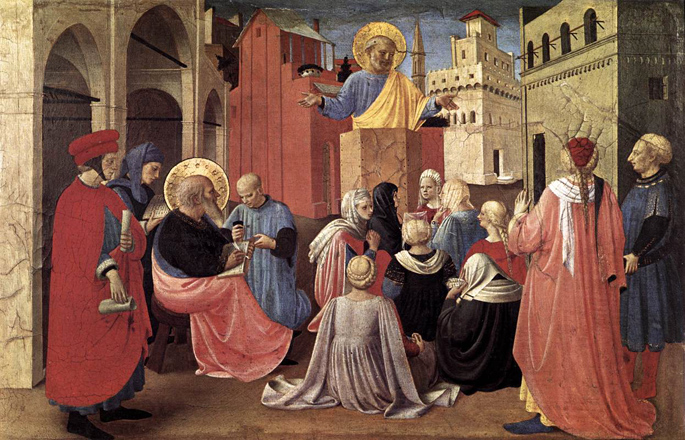
This panel is one of the three (at left) forming the predella of the Linaioli Altarpiece.
Quoted From: Web Gallery of Art - Fra Angelico
Adoration of the Magi: ca 1433

This painting is the central part of the predella of the Linaioli Tabernacle. The main panel of the tabernacle shows the Madonna with the Child, while the three predella pictures the Predicament of Saint Peter, the Adoration of the Magi and the Martyrdom of Saint Mark, respectively.
Quoted From: Web Gallery of Art - Fra Angelico
The Martyrdom of Saint Mark: ca 1433
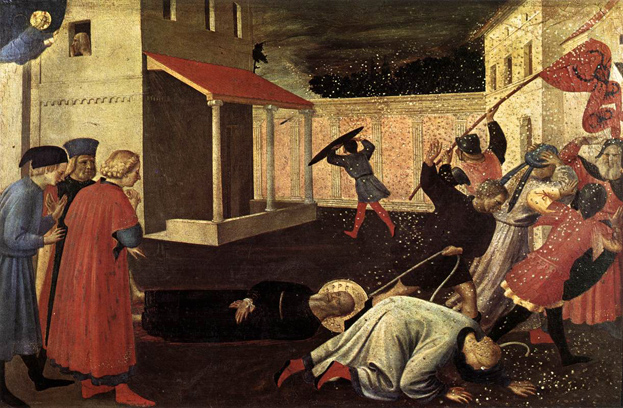
This panel is one of the three (at right) forming the Predella of the Linaioli Altarpiece.
Quoted From: Web Gallery of Art - Fra Angelico
The Cortona Polyptych: (ca 1437)
This polyptych, as shown by the recent restoration work, emerges from the combination
of three wood panels, painted at different times and for different reasons. It was placed
on a lateral altar in the church of Saint Dominic in Cortona. It was damaged during the
Second World War.
Cortona Polyptych: ca 1437
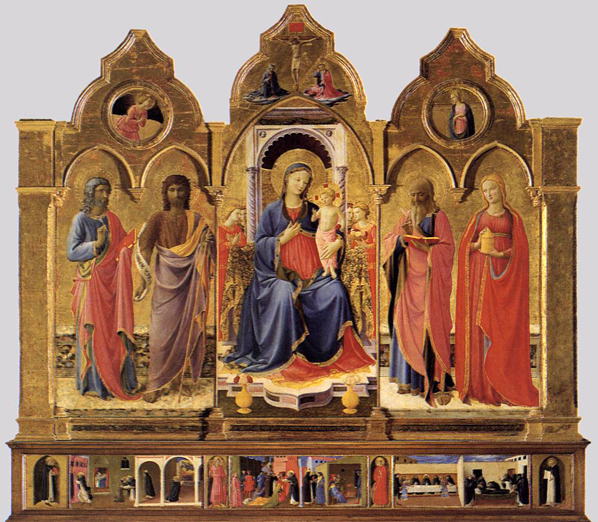
This polyptych, as shown by the recent restoration work, emerges from the combination of three wood panels of which it is formed, put together with the upper part and the border below. Therefore the three works must have been painted at different times and for different reasons. On the top are represented the Annunciation and the Crucifixion. In the middle of the polyptych there is a Virgin and Child. On the left Saints John the Baptist and John the Evangelist, while on the right Saints Matthew and Mary Magdalen are represented. On the predella episodes from the life of Saint Dominic, and other images of saints and angels are represented.
Art critics tend to date the older wood painting, the one with the Virgin, to 1434 and the complete work to 1437.
The triptych was placed on a lateral altar in the church of Saint Dominic in Cortona. At the beginning of the Second World War it was immured in the belfry where the wood suffered much damage due to humidity and temperatures. It was necessary to detach the painted surface and transfer it to a new base. It has been restored after many succeeding interventions. Unfortunately, it has lost its original solidity and need continuous reexamination.
Quoted From: Web Gallery of Art - Fra Angelico
Cortona Polyptych (Central Panel): ca 1437
_ca_1437.jpg)
This Madonna with the Child and Angels is the central part of the altarpiece called Cortona Triptych. On the left panel Saint John the Evangelist and Saint John the Baptist, on the right panel Saint Mark and Saint Mary Magdalen are depicted. The ten predella pictures show episodes of the life of Saint Dominic and standing figures of saints. The altarpiece was damaged during the Second World War and restored in 1946-50.
Quoted From: Web Gallery of Art - Fra Angelico
Cortona Polyptych (Detail): ca 1437
_ca_1437.jpg)
The peak of the central panel is occupied by a scene depicting the crucified Christ
with the Virgin and Saint John the Evangelist.
Quoted From: Web Gallery of Art - Fra Angelico
Cortona Polyptych (Detail): ca 1437
_ca_1437_Two.jpg)
At the top of the side panels two tondos represent the Annunciation.
This picture shows the angel of the Annunciation.
Quoted From: Web Gallery of Art - Fra Angelico
Cortona Polyptych (Detail): ca 1437
_ca_1437_Three.jpg)
At the top of the side panels two tondos represent the Annunciation.
This picture shows the Virgin of the Annunciation.
Quoted From: Web Gallery of Art - Fra Angelico
Cortona Polyptych (Detail): ca 1437
_ca_1437_Four.jpg)
The detail shows the head of Saint Matthew from the right panel.
Quoted From: Web Gallery of Art - Fra Angelico
Cortona Polyptych (Detail): ca 1437
_ca_1437_Five.jpg)
The detail shows the head of Mary Magdalene from the right panel.
Quoted From: Web Gallery of Art - Fra Angelico
Virgin with Child and Four Saints (Detail of the Predella): ca 1437
_ca_1437.jpg)
On the predella, beautifully painted in miniature, episodes from the life of Saint Dominic, and other images of saints and angels are represented.
The predella starts from the left with Saint Peter Martyr, followed by the scenes of Innocent III's dream of Saint Dominic holding up the falling church, the meeting of Saint Dominic and Saint Francis, then Saint Dominic receives the book and the stick by the Apostles Peter and Paul.
Quoted From: Web Gallery of Art - Fra Angelico
Virgin with Child and Four Saints (Detail of the Predella): ca 1437
_ca_1437_Two.jpg)
In the centre the predella continues with a representation of Saint Michael Archangel, then the scenes healing of Napoleone Orsini, dispute of Saint Dominic and a representation of Saint Vincent.
Quoted From: Web Gallery of Art - Fra Angelico
Virgin with Child and Four Saints (Detail of the Predella): ca 1437
_ca_1437_Three.jpg)
On the right side of the predella we can see the scenes of the angels serve dinner to the friars, the death of Saint Dominic, and, finally a representation of Saint Thomas Aquinas.
Quoted From: Web Gallery of Art - Fra Angelico
Perugia Triptych: (ca 1437)
This altarpiece was painted for the Saint Nicholas Chapel in the Church of San Domenico
at Perugia. The central panel depicts the Virgin and Child Enthroned with Four Angels
while the side panels represent Saint Dominic and Saint Nicholas of Bari, as well as
Saint John the Baptist and Saint Catherine of Alexandria. The three predella scenes depict
the story of Saint Nicholas. The triptych was dismembered and presently it is displayed without
its original frame in the Galleria Nazionale dell'Umbria in Perugia, except two predella panels
which are in the Pinacoteca Vaticana.
Quoted From: Web Gallery of Art - Fra Angelico
Perugia Altarpiece: ca 1437
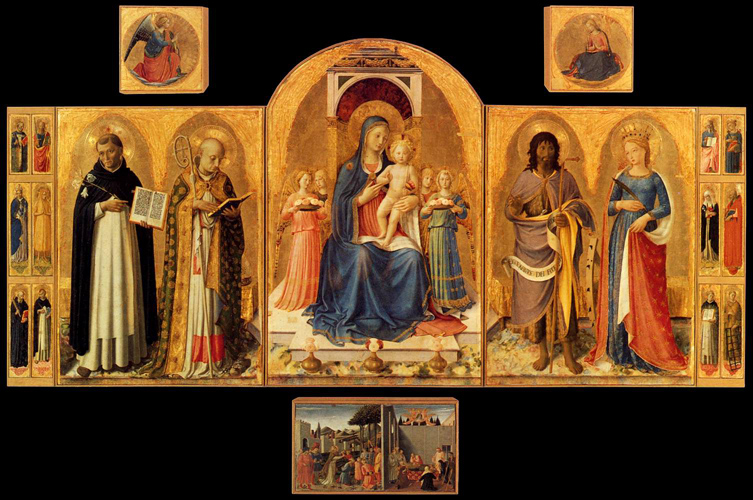
The picture shows the Perugia polyptych, without the complete predella.
Quoted From: Web Gallery of Art - Fra Angelico
Perugia Altarpiece - Central Panel: ca 1437
_ca_1437.jpg)
This panel, representing the Virgin and Child Enthroned with Four Angels, was at the centre of a polyptych painted for the Saint Nicholas chapel in the church of San Domenico at Perugia. The side panels represent Saint Dominic and Saint Nicholas of Bari, as well as Saint John the Baptist and Saint Catherine of Alexandria. The work is now displayed without its original frame, and the area which this covered can easily be seen along the upper edge of the panel. Compared with the Linaioli altarpiece, this Virgin is less monumental and the Child altogether more sinuous and fleshy. Angelico returns to the circle of angels to create an additional sense of depth, but here the two who would have stood forward of the throne have been replaced by three vases of flowers. The Virgin's throne is a solid classical affair with round arch and pilasters, topped with a swaged frieze. The background of the panel is still gold and abstract.
Quoted From: Web Gallery of Art - Fra Angelico
Perugia Altarpiece - Left Panel: ca 1437
_ca_1437.jpg)
Saint Dominic and Saint Nicholas of Bari stand to the Virgin's right. They lack the sculptural monumentality of the saints in the Linaioli altarpiece, are lit in a softer and more diffuse manner, and are not made to stand in a darkened niche. Here, for the first time Angelico breaks away from the convention of the abstract, all-surrounding gold, and places the figures in front of a long table, whose end can be seen behind Saint Nicholas of Bari who has placed his miter on it. This is not, however, so great a departure from convention as might be implied, as the table is covered with a golden cloth and beyond it is the usual gold background.
The two figures stand at the very front of the space created, Saint Dominic's foot and Saint Nicholas's vestments touching the edge of the step. Saint Nicholas wears his bishop's cope and supports his crook, while at his feet are three full leather bags. These refer to the most popular legend concerning this fourth-century churchman. He reputedly tossed bags of gold through the open window of a house, providing the three women who lived within with dowries and thus saving them from turning to prostitution. The event is shown, with two other scenes from the saint's life, in one of the predella panels from the altarpiece.
Quoted From: Web Gallery of Art - Fra Angelico
Perugia Altarpiece - Right Panel: ca 1437
_ca_1437.jpg)
Saint John the Baptist and Saint Catherine of Alexandria stand at the edge of the step and, like their companion saints in the altarpiece, have a table running behind them. Saint John's cross is tucked nonchalantly behind his halo and the base of it sticks right forward, but neither this nor his foreshortened hand recreate the impression of three-dimensionality with which he was rendered in the Linaioli altarpiece. He holds a scroll with a quotation from his own words, 'Behold the Lamb of God, which takes away the sin of the world', (John 1, v. 29). Saint Catherine has fewer sculptural qualities still. Beside her is a broken wheel from the diabolical machine on which she was tested. Some critics see the hand of assistants, rather than primarily that of the master, in these two figures.
Quoted From: Web Gallery of Art - Fra Angelico
The Story of Saint Nicholas: ca 1437
ca_1437.jpg)
The large altarpiece, called Perugia Triptych and executed for the Cappella di San Niccolo of the Church San Domenico at Perugia, contained three main panels, a predella with three pictures, and two decorated side pilasters. It was dismembered in later centuries. The majority of the parts are in the Galleria Nazionale dell'Umbria at Perugia, while two of the predella paintings are in the Vatican.
The central part of the triptych represents the Madonna with the Child and Angels, while on the side parts four saints are shown. The predella depicts the story of Saint Nicholas.
The first predella painting (this picture) shows the birth of Saint Nicholas (on the left), The Vocation of Saint Nicholas (in the center) and the Giving Dowry to Three Poor Girls (on the right).
This scene refers to the most popular legend concerning this fourth-century churchman. He reputedly tossed bags of gold through the open window of a house, providing the three women who lived within with dowries and thus saving them from turning to prostitution. The event is shown, with two other scenes from the saint's life, in one of the predella panels from the altarpiece.
Quoted From: Web Gallery of Art - Fra Angelico
Story of Saint Nicholas Birth of Saint Nicholas (Detail): ca 1437
_ca_1437.jpg)
Detail of the first predella paintings on the Perugia Triptych. The predella depicts the story of Saint Nicholas.
Quoted From: Web Gallery of Art - Fra Angelico
The Story of Saint Nicholas Giving Dowry to Three Poor Girls: ca 1437
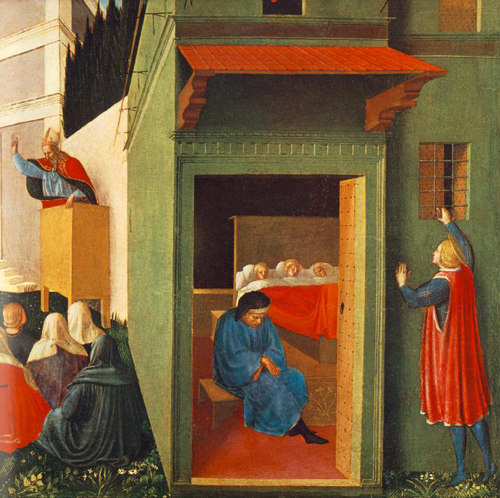
Detail of the first predella paintings on the Perugia Triptych. The predella depicts the story of Saint Nicholas.
The Story of Saint Nicholas - Saint Nicholas saves the Ship: ca 1437

The Story of Saint Nicholas - Saint Nicholas Saves the Ship (Detail): ca 1437
_ca_1437.jpg)
The second predella painting shows the meeting of Saint Nicholas with the messenger of the Emperor (on the left) and the miraculous saving of a ship (on the right).
Quoted From: Web Gallery of Art - Fra Angelico
The Story of Saint Nicholas - Saint Nicholas Saves the Ship (Detail): ca 1437
_ca_1437_Two.jpg)
The third predella painting shows the liberation by Saint Nicholas of three innocents condemned (on the left, not shown in this picture) and the death of the Saint (on the right).
On the right side of this panel the starkness of a lightly articulated wall forces attention on the dying saint.
Quoted From: Web Gallery of Art - Fra Angelico
San Marco Altarpiece (1438-40)
The San Marco Altarpiece was removed and dismembered in the seventeenth century
during the renovation of the church belonging to the Convent of San Marco and
dedicated to the two medical saints, Cosmas and Damian. In addition to the main
painting representing the Virgin and Child Enthroned with Angels and Saints, there were
nine predella pictures, seven in the front and two on the lateral sides. Only two of the
predella paintings remained in the Convent, all the others are now in different museums
(in Washington, Munich, Dublin and Paris).
Based on the results of thorough research, scholars agreed in the reconstruction of the
altarpiece. The predella pictures depict the story of Saint Cosmas and Saint Damian on
eight small panels, while the ninth, located in the centre, represents the Entombment (Pietà).
San Marco Altarpiece: 1438-40

This is the main painting of the altarpiece, called San Marco Altarpiece. It represents the Virgin and Child Enthroned with Angels and Saints, it was executed for the main altar of the church belonging to the Convent of San Marco and dedicated to the two medical saints, Cosmas and Damian.
The altarpiece, one of the most grandiose of the Quattrocento altars, was executed after the decision of Cosimo de' Medici in 1438 to transfer to Cortona the triptych which served as main altar of the convent church. It depicts, in the front, the kneeling Saints Cosmas and Damian, then in the second row, from the left: Saints Lawrence, John the Evangelist, Mark, Dominic, Francis and Peter the Martyr. It is assumed that the figure of Saint Cosmas is the likeness of Cosimo de' Medici. In the lower center a Crucifixion with golden background can be seen.
Quoted From: Web Gallery of Art - Fra Angelico
San Marco Altarpiece: (Detail) 1438-40
_1438_40.jpg)
The Healing of Palladia by Saint Cosmas and Saint Damian: 1438-40
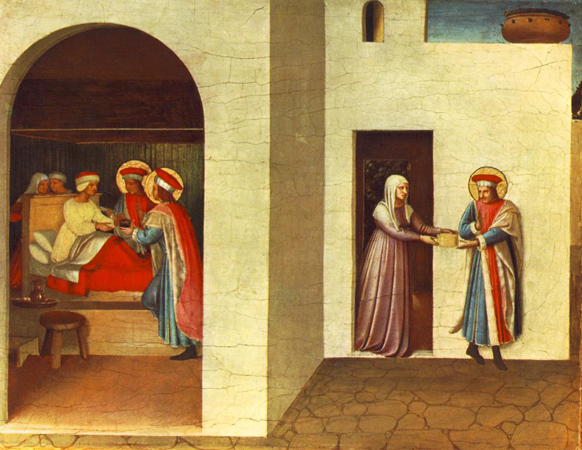
On this picture, which was placed on the left lateral side of the altarpiece, two consecutive episodes are shown. On the left the two Arab physicians effect a miraculous cure; on the right Saint Damian, contrary to his vows, unwillingly accepts a gift.
Quoted From: Web Gallery of Art - Fra Angelico
Saint Cosmas and Saint Damian before Lisius: 1438-40

This picture is the first from the left on the predella.
Saint Cosmas and Saint Damian Salvaged: 1438-40
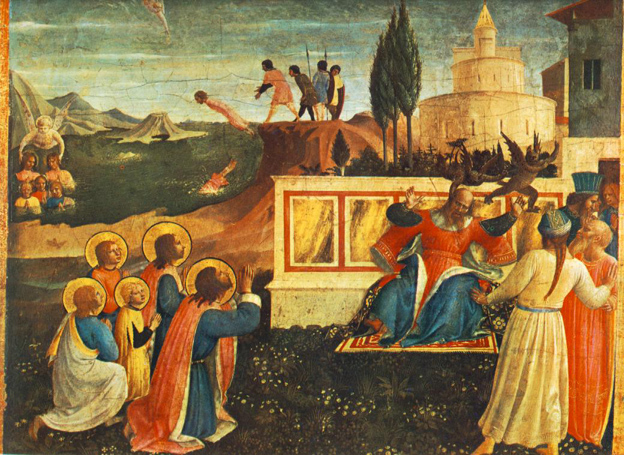
This picture is the second from the left on the predella.
Saint Cosmas and Saint Damian Condemned: 1438-40

This picture is the third from the left on the predella.
Entombment: 1438-40
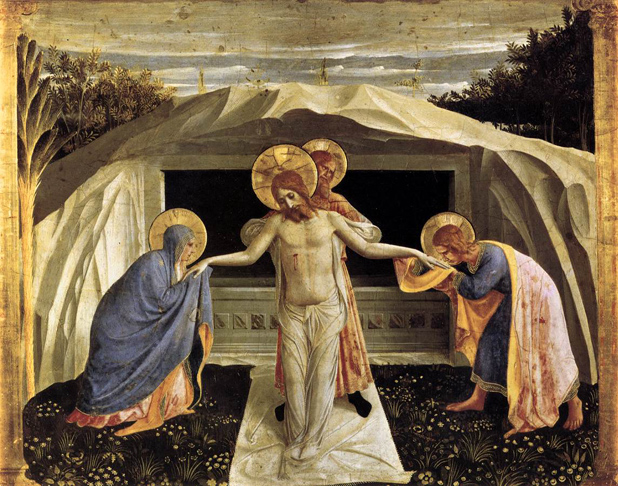
This panel was part of the altarpiece of the main altar in the monastery church of San Marco, Florence, and was originally in the middle of its predella.
The center predella panel of the San Marco altarpiece is not overtly connected to the scenes on either side of it, which show the life of Saints Cosmas and Damian, although it too is lit from the right. Instead it relates directly to the crucifixion at the base of the altarpiece which, when the predella was in situ, was immediately above it. Christ's body is supported by Nicodemus, and his hands are held and kissed by the stooping Virgin and St John. Christ has a weightless air about him, so that the three other figures appear to have to do little to support him. The winding cloth lies stretched out in a receding rectangle creating the foreground space, its folds and color echoing the white rock. Behind lies the dark rectangular void of the tomb. The sparsity and simplicity of the composition, the firmly closed-off space and the extensive use of white in this panel, are all also found in Angelico's frescoes at San Marco.
The figures here, arranged parallel with each other, with the central perspective of the shroud leading to the tomb, shows a very different idea of spatial organization from that in Rogier van der Weyden's panel of the same subject
Quoted From: Web Gallery of Art - Fra Angelico
Saint Cosmas and Saint Damian Crucified and Stoned: 1438-40
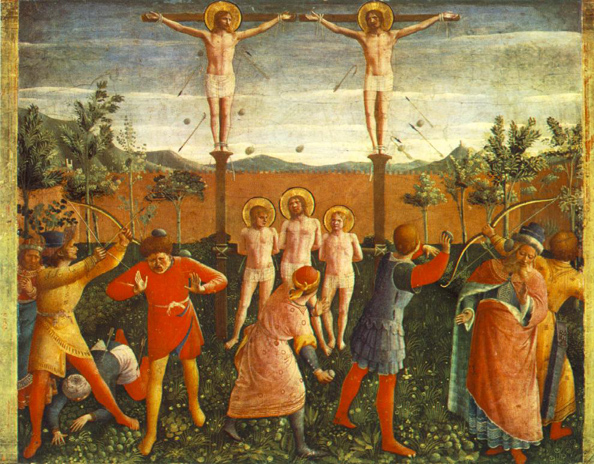
This picture is the third from the right on the predella.
Beheading of Saint Cosmas and Saint Damian: 1438-40
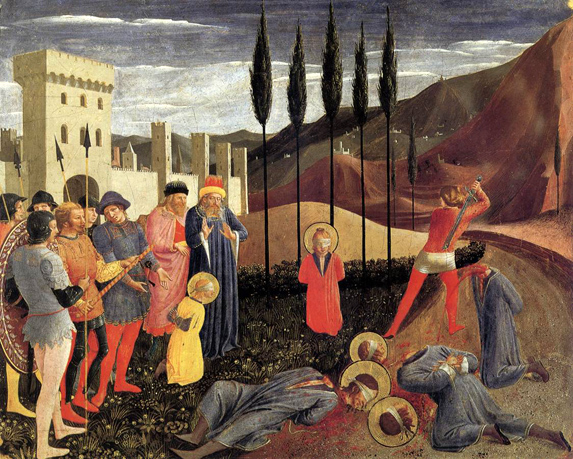
This picture is the second from the right on the predella. The legend of Saints Cosmas and Damian, twin brothers who were famed for making no charges for their services as physicians, is outlined in the predella panels of this San Marco altarpiece. Several attempts to put them to death failed, until the last, pictured here. The final moments of the two brothers are shown set against one of Angelico's finest landscapes. Outside a town with fortifications akin to those of Jerusalem in his Deposition, the two saints wait to join the three headless figures in the foreground. The greatest emphasis falls on the one who kneels directly in front of a row of five cypresses which runs parallel to the picture plane. The trees can be taken to symbolize the five being executed.
Quoted From: Web Gallery of Art - Fra Angelico
Sepulchering of Saint Cosmas and Saint Damian: 1438-40
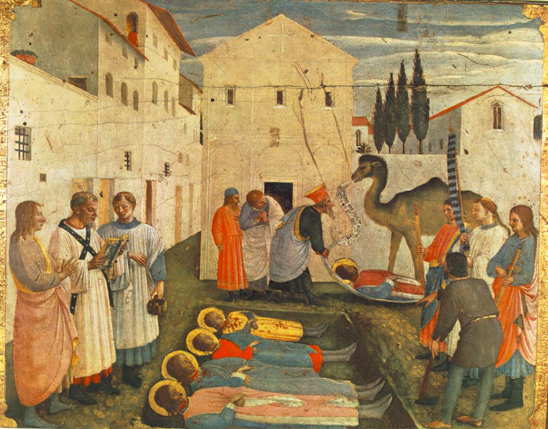
This picture is the first from the right on the predella.
The Healing of Justinian by Saint Cosmas and Saint Damian: 1438-40
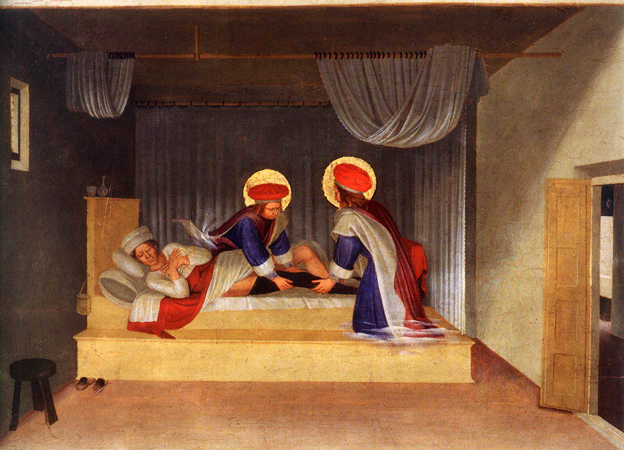
This picture was placed on the right lateral side of the altarpiece. Justinian sleeps while Saints Cosmas and Damian enter his chamber trailing patches of soft cloud. They replace his corrupted leg with a healthy one. The room is Spartan but the variety of light-sources and Angelico's close observation give it interest. Light floods in from outside through the window on the left, illuminating its own frame and parts of the swags of curtain. Exterior space is indicated not only by the window but by the door opposite it, from whence comes more light. From the front left outside the picture comes the third source of light, which produces a broad diagonal sweep across the right wall. The curtain provides the rectangular backdrop parallel to the picture surface which is common to each of these predella panels, and also hints at more, obscured space behind it. The container hanging from a nail on the side of the bed, the glass and decanter, the slippers and the simple three-legged stool, all provide the constituents of a closely observed still-life.
Quoted From: Web Gallery of Art - Fra Angelico
Saint Jerome: 1438-40
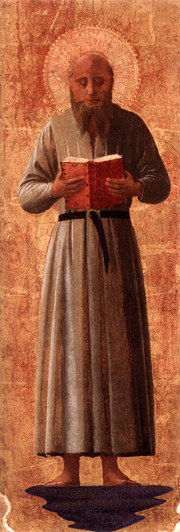
The three panels in the Lindenau-Museum, Altenburg, representing Saint Jerome, Saint Bernard, and Saint Roche, were part of the altarpiece (the San Marco Altarpiece) executed for the main altar of the church belonging to the Convent of San Marco and dedicated to the two medical Saints, Cosmas and Damian. The altarpiece with a Sacra Conversazione in the center, was dismembered and the parts dispersed.
Quoted From: Web Gallery of Art - Fra Angelico
Saint Roche: 1438-40
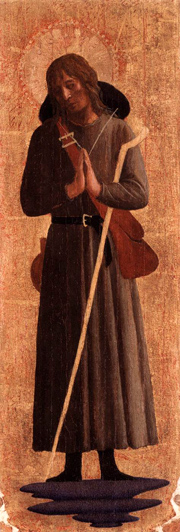
Saint Bernard: 1438-40

Saint Romuald: ca 1440
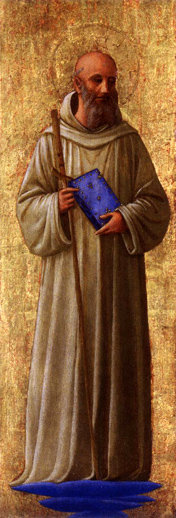
This panel probably was part of the San Marco Altarpiece.
Saint Peter Martyr: 1340-45
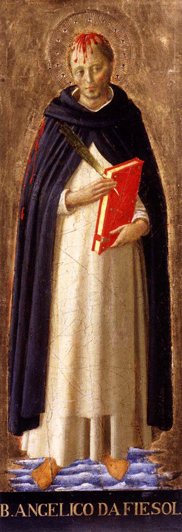
This panel probably was part of the San Marco Altarpiece.
Saint Thomas Aquinas: 1340-45
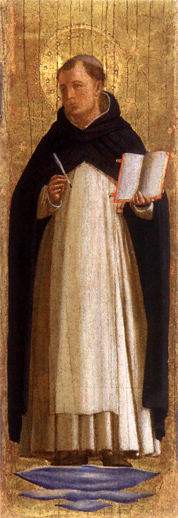
This panel probably was part of the San Marco Altarpiece.
Santa Trinità Altarpiece: (1437-40)
The altarpiece was originally in the sacristy of the church Santa Trinità in Florence.
The main panel shows the Deposition while the pilasters on both sides figures of different
saints. The Deposition is fundamentally a Renaissance work of art with some nostalgic
Gothic details (mainly the group of women on the left side).
Deposition from the Cross (Pala di Santa Trinità): 1437-40
_1437_40.jpg)
This work was originally commissioned by Palla Strozzi from Lorenzo Monaco, for the sacristy of the church of Santa Trinità in Florence, but by the time of Monaco's death only the pinnacles of this work had been painted. When Angelico took over the commission he found himself cribbed and confined by Monaco's ready-made triple-arched Gothic frame. He ignored these constraints, however, making skilful use of the three arches in his composition to provide a scene of stunning beauty and subdued yet poignant emotion, set in an expansive Tuscan landscape. Although the work is painted on one panel, the three arches of the frame find an echo in the placing of the figures in three groups.
The central arch is largely blocked off by the wooden framework of the cross and two ladders. The cross bar of the former appears to run behind the picture frame hinting at further, obscured space. With no scene behind but the sky and the lattice work of timber, the eye is drawn to the body of Christ which is at the very center of the picture. Angelico challenges the tendency of the other two arches to define the shape and space of the work by placing a strong vertical, in the form of a tower or a tree, in the corners of each. The pilasters on either side of the frame contain twelve panels with full length portraits of saints, and eight medallions with portrait busts. The full-length figures are shown standing on columns which are each painted with careful attention to the view-point of the spectator.
Quoted From: Web Gallery of Art - Fra Angelico
Deposition from the Cross (Detail): 1437-40
_1437_40.jpg)
Deposition from the Cross (Detail): 1437-40
_1437_40_Two.jpg)
The cross has no upper limb, thereby blunting the pointedness of the arch behind which it stands. There is room at the top only for a view of the mocking panel which declares Christ King of the Jews. Christ is covered with the weal of the flagellation, and blood trickles from the lance wound in his side. More blood runs down the cross to the rock at the base, a stylized representation of Golgotha. Christ's head lies almost horizontally, his passive face marked only by thin dribbles of blood from the pricks of the crown of thorns.
Vasari claims that one of the figures lowering Christ is a portrait of Michelozzo, the architect responsible for the rebuilding of the convent of San Marco in Florence. Pope-Hennessy suggests that if he is represented at all it is in the figure under Christ's right arm wearing a black cappucio, or monastic hood.
Quoted From: Web Gallery of Art - Fra Angelico
Deposition from the Cross (Detail): 1437-40
_1437_40_Three.jpg)
In the distance at the top left lies Jerusalem, shown by Angelico as a sparkling Tuscan hill town. The city fortifications appear as a series of cubes, pillars, and walls massed together in a sharply defining light. Buildings of widely varying sizes, shapes and colors are arranged together within the city walls. At the top of the hill rises a citadel-like temple. Outside the city gates lies a landscape of ploughed fields, farmhouses, and hedgerows. In the sky, above a storm cloud is gathering which throws shadow over half the city. The whole is viewed through a screen of trees, which mark out the middle distance in the complete picture.
Quoted From: Web Gallery of Art - Fra Angelico
Deposition from the Cross (Detail): 1437-40
_1437_40_Four.jpg)
In this detail the towered buildings confirm the landscape as Italian. The hills stretch out into the distance, softened and smoothed by the light, peppered with gleaming villages and farmhouses. The foreground rocks are insufficiently distant to be mellowed, and are shown with all their facets and angularity. A row of trees again screens the landscape, emphasizing its distance.
Quoted From: Web Gallery of Art - Fra Angelico
Deposition from the Cross (Detail): 1437-40
_1437_40_Five.jpg)
Angelico stops short of portraying the figures lamenting Christ's death in the agonies of grief; instead he shows them in languorous contemplation of their inner sorrow. Mary Magdalen kneels before Christ, taking his feet in her hands and kissing them. The Virgin kneels, her hands clasped, head on one side in reflective misery, with an air of particular detachment. She is partly screened from the viewer by the winding sheet held before her. The other holy women stand in positions of contemplation or prayer; one wipes a tear from her eye. As in earlier paintings by Angelico, the sense of the space in which the Virgin kneels is created by placing figures in a circle around her. In the background the road begins to wind its way up to Jerusalem.
Quoted From: Web Gallery of Art - Fra Angelico
Deposition from the Cross (Detail): 1437-40
_1437_40_Six.jpg)
Kneeling in the foreground of the picture is a Beato. He echoes the Magdalen in his position, pose and red gown. A foreshortened arm extends out towards the viewer, drawing us into the scene before us. It has been suggested that this figure is Alessio degli Strozzi, the dead son of the family whose patronage brought about the creation of the work. Behind him are five men, standing further forward in the picture plane than the women on the other side whom they balance. Like the women each is contemplative, reticent and mournful. One displays to the others some of the instruments of crucifixion: three gruesomely large nails with heavy drips of blood on them, and the neatly woven circlet of thorns whose perforations can be seen on Christ's brow. Beneath their feet, indicative of Angelico's enjoyment of the portrayal of nature, is the richly leafed and flowered turf which is common to so many of his paintings.
Quoted From: Web Gallery of Art - Fra Angelico
Deposition from the Cross (Detail): 1437-40
_1437_40_Seven.jpg)
This detail demonstrates Fra Angelico's skillful treatment of landscapes.
Deposition from the Cross (Detail): 1437-40
_1437_40_Eight.jpg)
Fra Angelico's Deposition demonstrates not only his skillful treatment of landscapes, but also figures, to which he often gave specific and presumably identifiable features. The man in the turban is likely a portrait of a person known to the artist.
Various Altarpieces
Quoted From: Web Gallery of Art - Fra Angelico
Saint Peter Martyr Altarpiece: 1427-28
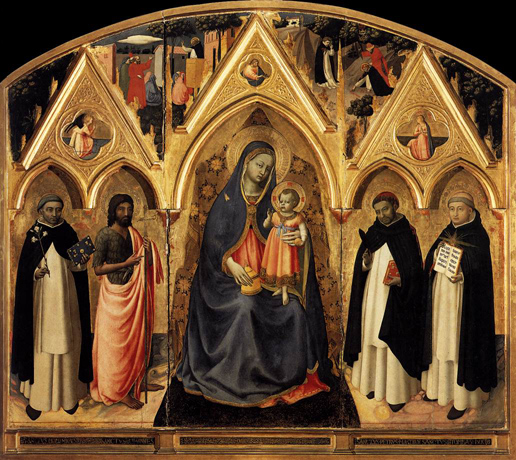
In this early altarpiece by Fra Angelico the Virgin and Child are in the centre, while Saints Dominic and John the Baptist are represented on the left and Saints Peter Martyr and Thomas Aquinas on the right. On the upper part scenes from the life of St Peter Martyr are depicted.
Compagnia di San Francesco Altarpiece: ca 1429

The altarpiece Madonna and Child with Saints Jerome, John the Baptist, Francis and Onophrius is known as the Compagnia di San Francesco Altarpiece.
Fra Angelico's renown extended beyond the congregations of his Order. In accord with the mission of Saint Dominic to evangelize, the friar expressed the lessons of his faith for numerous clients. Documents demonstrate that a range of patrons sought his work throughout the 1420's. In 1429, the penitential confraternity of San Francesco, which met in the cloister of Santa Croce, paid Fra Angelico ('frate Guido') for its altarpiece. Though the altarpiece was cut apart at some point in its history, its components have been identified. The central and lateral panels are in the Museo di San Marco, Florence, while the predella panels are dispersed in various collections.
Trial by Fire: ca 1429
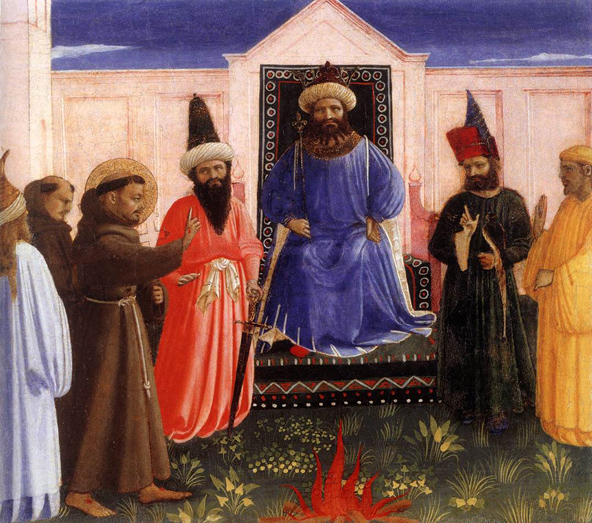
This painting was part of the predella which belonged to a triptych of the Madonna and Child with Four Saints (known as the Compagnia di San Francesco Altarpiece), commissioned for the convent of Santa Croce in Florence 1429. The five predella panels depicting scenes from the life of Saint Francis of Assisi are the following:
1. Trial by Fire (Lindenau-Museum, Altenburg)
2. Receiving the Stigmata (Pinacoteca Vaticana, Rome)
3. Meeting of Saint Francis and Saint Dominic (Staatliche Museen, Berlin)
4. Apparition of Saint Francis at Arles (Staatliche Museen, Berlin)
5. Lamentation over Saint Francis (Staatliche Museen, Berlin)
Receiving the Stigmata: ca 1429
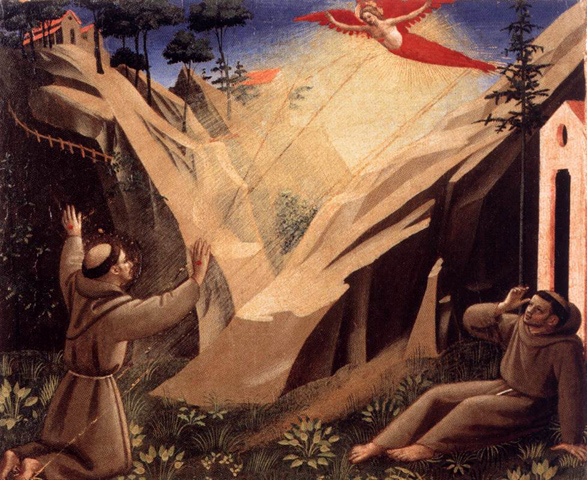
The five predella panels depicting scenes from the life of St Francis of Assisi are the following:
1. Trial by Fire (Lindenau-Museum, Altenburg)
2. Receiving the Stigmata (Pinacoteca Vaticana, Rome)
3. Meeting of Saint Francis and Saint Dominic (Staatliche Museen, Berlin)
4. Apparition of Saint Francis at Arles (Staatliche Museen, Berlin)
5. Lamentation over Saint Francis (Staatliche Museen, Berlin)
Meeting of Saint Francis and Saint Dominic: ca 1429

The five predella panels depicting scenes from the life of St Francis of Assisi are the following:
1. Trial by Fire (Lindenau-Museum, Altenburg)
2. Receiving the Stigmata (Pinacoteca Vaticana, Rome)
3. Meeting of Saint Francis and Saint Dominic (Staatliche Museen, Berlin)
4. Apparition of Saint Francis at Arles (Staatliche Museen, Berlin)
5. Lamentation over Saint Francis (Staatliche Museen, Berlin)
Apparition of Saint Francis at Arles: 1440's

The five predella panels depicting scenes from the life of St Francis of Assisi are the following:
1. Trial by Fire (Lindenau-Museum, Altenburg)
2. Receiving the Stigmata (Pinacoteca Vaticana, Rome)
3. Meeting of Saint Francis and Saint Dominic (Staatliche Museen, Berlin)
4. Apparition of Saint Francis at Arles (Staatliche Museen, Berlin)
5. Lamentation over Saint Francis (Staatliche Museen, Berlin)
Lamentation over Saint Francis: 1440's

The five predella panels depicting scenes from the life of St Francis of Assisi are the following:
1. Trial by Fire (Lindenau-Museum, Altenburg)
2. Receiving the Stigmata (Pinacoteca Vaticana, Rome)
3. Meeting of Saint Francis and Saint Dominic (Staatliche Museen, Berlin)
4. Apparition of Saint Francis at Arles (Staatliche Museen, Berlin)
5. Lamentation over Saint Francis (Staatliche Museen, Berlin)
Fiesole Altarpiece: (Detail) 1428-30
_1428_30.jpg)
This is the center part of the altarpiece painted for the altar of the church of San Domenico at Fiesole, just outside Florence. Originally a triptych, it was radically altered into a single panel in 1501. In the center the Virgin and Child enthroned with eight angels is depicted, while on the left part Saint Thomas of Aquino and Saint Barnabas, on the right Saint Dominic and Saint Peter the Martyr are represented (not seen in this detail). The seven pictures of the predella now are in the National Gallery in London.
The eight angels in front, beside, and behind her create the space in which the Virgin sits. The Virgin's gown falls in a restrained manner, her head inclined to one side. The plump cheeks and closely curled hair of Christ and the angels owe much to the manner of Gentile da Fabriano, exponent of the fourteenth-century International Gothic style, who was the dominant painter in Florence during his stay there from 1422 to 1425/6.
Christ Glorified in the Court of Heaven: 1428-30
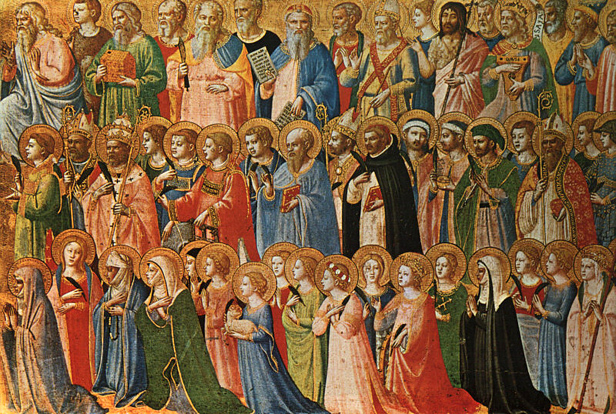
This painting is one of the seven predella pictures of the Fiesole Altarpiece, all exhibited in the National Gallery in London.
Saint Nicholas of Bari: 1438-40
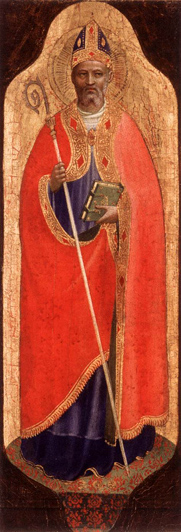
This panel probably was part of the San Domenico di Fiesole Altarpiece, before being modernized by Lorenzo di Credi in 1501
Saint Michael 1438-40
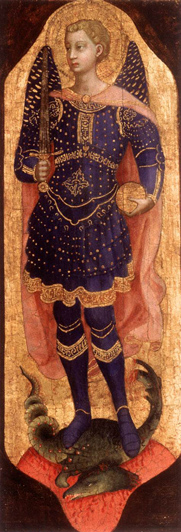
This panel probably was part of the San Domenico di Fiesole Altarpiece, before being modernized by Lorenzo di Credi in 1501.
Saint Mark 1438-40
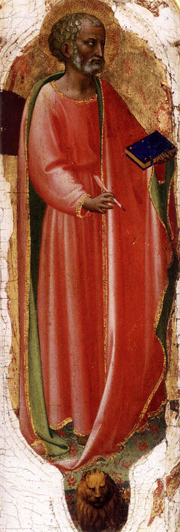
This panel probably was part of the San Domenico di Fiesole Altarpiece, before being modernized by Lorenzo di Credi in 1501.
Saint Matthew 1438-40
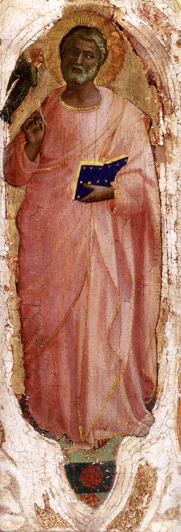
This panel probably was part of the San Domenico di Fiesole Altarpiece, before being modernized by Lorenzo di Credi in 1501.
Coronation of the Virgin: 1434-35
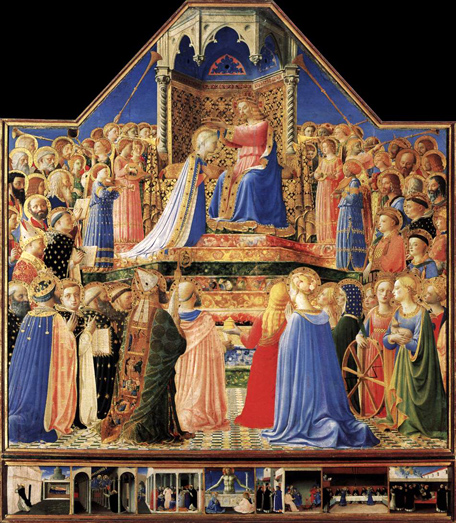
This altarpiece, exhibited now in the Musée du Louvre together with its seven predella pictures, was executed for the Church San Domenico in Fiesole, and it is one of the most famous of Fra Angelico's works. It is a good example of the painter's art of tempera painting with fresh colors that have not changed. On the predella the story of San Domenico is depicted.
In this altarpiece Fra Angelico departs markedly from his usual methods of space projection, but this can be explained by the extreme difficulty of integrating so complex a composition as a traditional Coronation, into the type of space he had recently employed. The whole, although still a heavenly scene, is set on terra firma. The sky is a realistic blue and not gold. The very low view-point enables the assembled saints and angels to be placed in a series of tiers without obscuring one another. The figures in the foreground kneel so as not to attract undue emphasis. Mary Magdalen holds out her jar of oil, marking the central axis.
Recently a date of 1450, which is considered compatible with the internal dating evidence of this altarpiece, is suggested.
Coronation of the Virgin (Detail): 1434-35
_1434_35.jpg)
Saint Nicholas of Bari is shown kneeling in the foreground of The Coronation of the Virgin with his Episcopal Miter and crook. Saint Nicholas's cope shows several scenes from the Passion, including the Betrayal, Mocking, and Flagellation. To his left are Saint Anthony and Saint Francis of Assisi.
Coronation of the Virgin (Detail): 1434-35
_1434_35_Two.jpg)
Saint Catherine of Alexandria stands holding her wheel and regarding Saint Agnes, who clutches her own symbol, a lamb. Saint Agnes's robe falls in heavy sculptured loops to the ground. The haloes of the two saints are carefully arranged so that Saint Catherine's face is not obscured. The haloes in this painting are treated very flatly but in some cases also extremely decoratively, being studded with gems.
Coronation of the Virgin (Detail): 1434-35
_1434_35_Three.jpg)
Fra Angelico dedicated several of his works to the scene of Mary's coronation (Louvre, Paris; Museo di San Marco, Florence, Uffizi, Florence). In these pictures the ceremoniousness of the event is lessened by the gentle charm of the details.
This painting is from the Church of Sant'Egidio of Ospedale di Santa Maria Nuova in Florence. Its approach is special in that it presents the scene in the sky, floating on clouds, thus placing Jesus and Mary and their surrounding entourage in an interesting perspective. Spatial relations are illustrated by the use of size differences, the virtuoso rendering of light-rays, and color perspective.
The angelic choir greets the Queen of Heavens with song and dance. In the right foreground, with his back to the viewer, an angel dressed in blue plays the portative organ; his companion to the left a stringed instrument. Above, on both sides of the main group, the trumpets are raised high above the heads. Among the other instruments we can recognize a beautiful lute on the left, and a small oval-shaped violin (or mandola) on the right. The inner ring is composed of six tall, dancing angels; their flowing robes and the position of their hands indicate the direction of their movement.
Annunciation 1430's
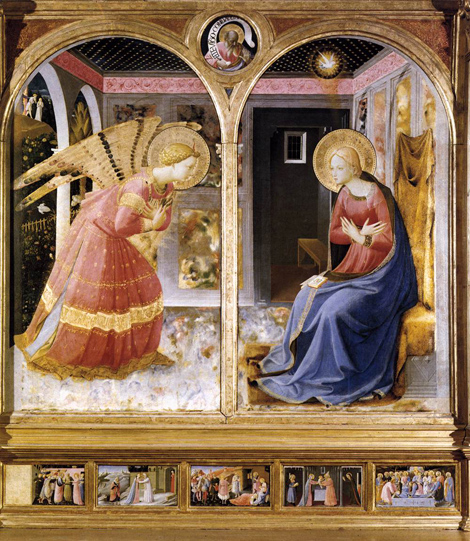
The attribution and the dating of this painting was long debated. However, after a successful restoration it is today appreciated as one of the painter's masterpieces. The artist returned time after time to his favorite theme of the angel bringing the news and the devout Mary in a posture of humble acceptance.
The size of the main panel is 149 x 158 cm, while the five predella panels, representing five scenes of the life of the Virgin (the Marriage of the Virgin, the Visitation, the Adoration of the Magi, the Presentation of Jesus at the Temple, and the Funeral of the Virgin), have the size of 17 x 26 cm each.
Annalena Altarpiece ca. 1445
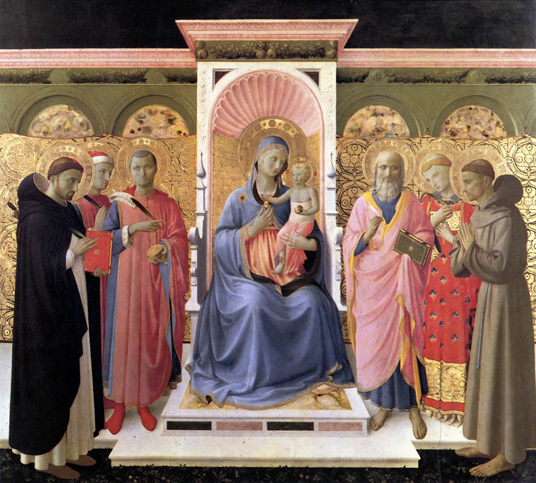
The painting got the name from its original location, the Convento di San Vincenzo d'Annalena, founded by Annalena Malatesta.
This is Angelico's second sacra conversazione, and shares many elements in common with its forerunner, the San Marco altarpiece. Unlike the San Marco altarpiece, however, there are no angels here and the Virgin and Child are in the company only of Saints Peter Martyr, Cosmas, Damian, John the Evangelist, Lawrence and Francis. Although they have left their individual panels, never to return, there is still an echo of these in the blank arches of the wall which closes the back of the picture.
The high wall and its pink cornice run the full width of the panel. The natural world, which was the setting of the first altarpiece, is now confined to the grass and flowers at the very front of the picture. There is no carpet on the ground here and the foreground is much shallower than in the earlier work. The method of space projection remains basically the same and relies on the receding rectangles of the steps to the throne and of its cornice. An element common to both altarpieces is the use of a carpet running across the back of the picture parallel to the picture plane.
Bosco ai Frati Altarpiece ca. 1450
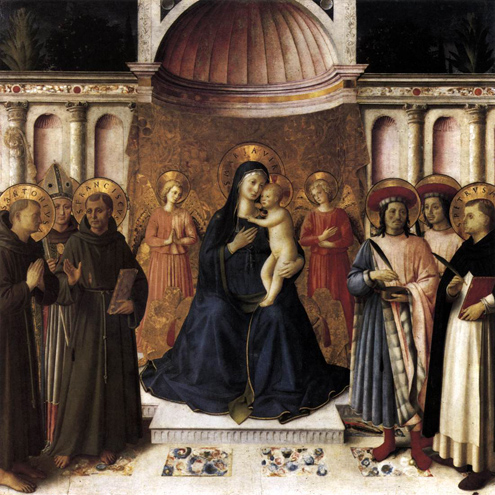
This altarpiece was painted by Angelico after his return from Rome for the Franciscan convent of Bosco ai Frati in Mugello. It was probably commissioned by Cosimo de' Medici who started the renovation of the convent in 1438.
The altarpiece shows further developments of the formula that underlies his earlier sacra conversazione. The architecture is richer and more plastic, so that its articulation of the picture space is partly camouflaged. The throne has been widened and heightened, now looking like the apse of a small church, bringing greater emphasis to the Virgin and Child at the expense of the saints. The wall is enlivened by a series of recessions and projections in the form of niches and half ionic columns. Although the grass and flowers have been excluded from the foreground, the natural world reasserts itself, albeit in a symmetrical composition, behind the wall.
Triptych: The Last Judgment ca. 1450
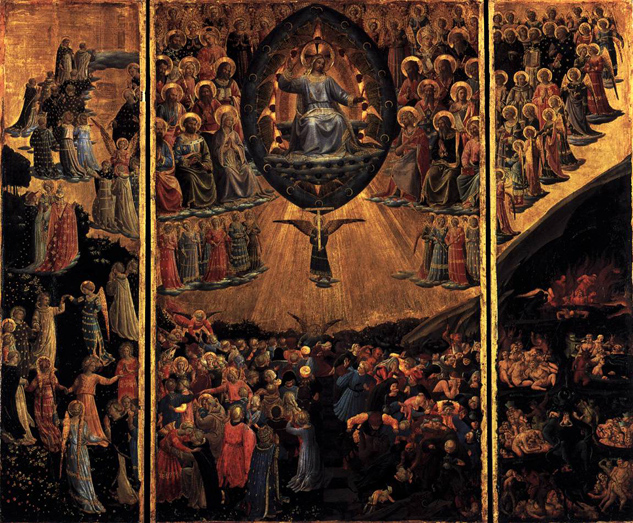
Fra Angelico's late Last Judgment is close to Trecento sources, to the school of Orcagna in particular. It was painted when the popular artist had a large studio. Perhaps the painting is by Zanubi Strozzi, who was predominantly a manuscript illuminator. Originally on a single panel, the scene was cut into thirds at a much later date.
Frescoes in the Convento di San Marco: 1438-50
The return of Cosimo de' Medici to Florence in 1434 enabled the Dominicans, of whom he had long been a patron, to secure for themselves the ruined convent of San Marco. Its rebuilding began in 1437, and its decoration very soon after. The San Marco frescoes were intended not as means of instruction, still less as decoration, but as aids to contemplation and meditation. The brother who inhabited each cell was to have constantly before his eyes a vivid yet chaste reminder of one of the events in the life of Christ.
Quoted From: Web Gallery of Art - Fra Angelico
View of the Convent of San Marco 1436
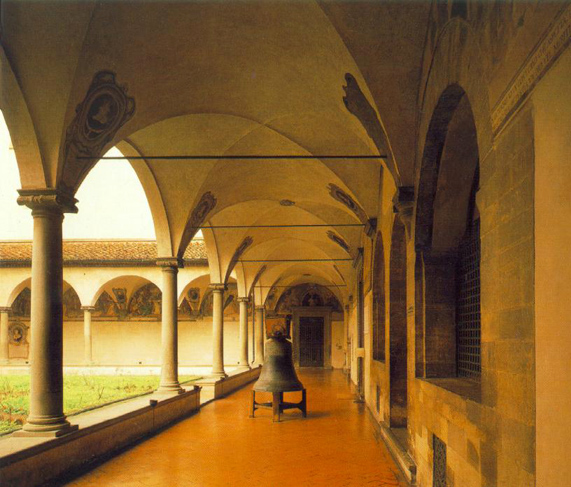
The Museum of San Marco is located in the former monastery of the Dominicans, constructed by Michelozzo in 1436 on a commission from the Medici ruler Cosimo the Elder. Michelozzo here adheres firmly to the Renaissance forms of Brunelleschi, even though his classicism has none of the other's passion for archeological research in it. The smooth, flowing lines of the cloister's arches create effects of light and shade which alternate in the series of vaults. Naturally the religious function and the deliberately spiritual effect of the structure, suggested by the order's Vicar General and perhaps by Fra Angelico himself, qualify these chiaroscuro and plastic impressions. The history of San Marco is inseparably linked to the figures of the painters, Fra Angelico and Fra Bartolommeo, and the friar Girolamo Savonarola.
The figure of Angelico dominates in the Convent. The friar painter lived a long time here and expressed here his delicate and simple soul in the sincere, candid forms of art. But a great part, not only the artistic, but of the religious and civil history of Florence developed here.
In the cloisters, in the dormitories, in the cells we find the conventional character well-preserved in the harmonious architectural plan. We also find the memory of San Antonino, who entered here as a friar, and, it is said on the advice of Angelico, came out of it in 1445 Archbishop of Florence; and the memory of Savonarola, who came here in 1489, and was later prior of the convent and who from here raised himself against the decadence of habits calling the people to liberty and democratic arrangement; and the memory, above that of Angelico's almost unknown collaborators, of a great friar painter, Fra Bartolommeo.
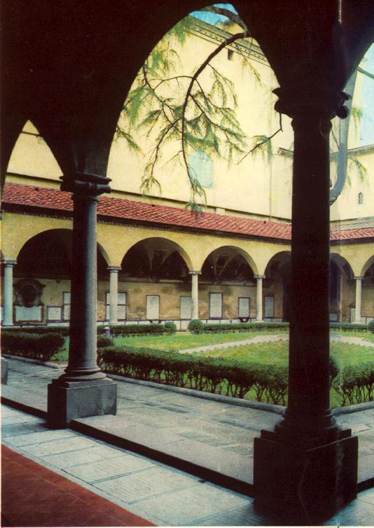
Frescoes in the Upper Floor Cells
Quoted From: Web Gallery of Art - Fra Angelico
Noli Me Tangere 1440-41
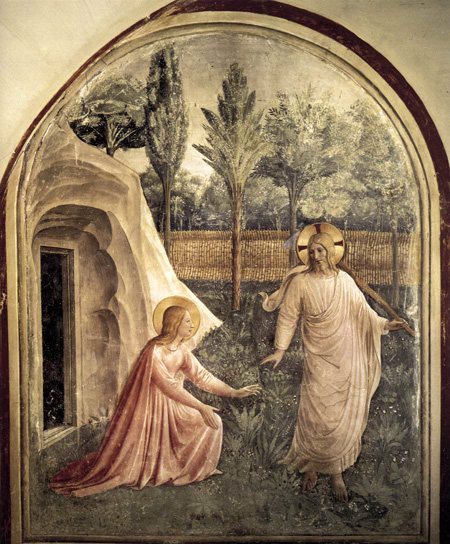
This is the fresco on the wall of Cell One of the Convento di San Marco in Florence.
The brilliance of the early morning is real enough, but the irradiating light, the floating rather than walking figure of Christ, the wealth of natural detail in the garden, are for devotional reasons and intended to stimulate the meditation of the monk who lived in the cell.
View of a Cell 1440-41
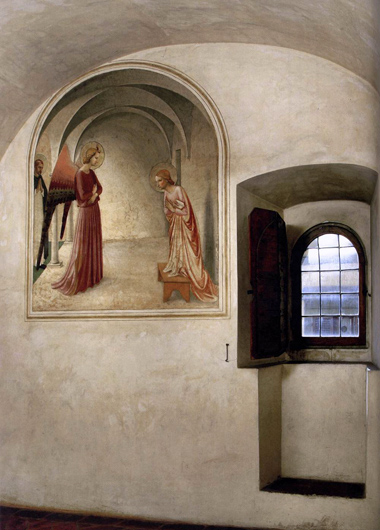
The picture shows a view of Cell Three of the Convento di San Marco in Florence. The fresco on the wall depicts the scene of the Annunciation with a standing angel and a kneeling Virgin, slight and frail, who holds her open book to her breast.
Annunciation 1440-41

This is the fresco on the wall of Cell Three of the Convento di San Marco in Florence.
On the left Saint Peter the Martyr is represented. This is a favorite theme, here simplified. A contribution of Angelico's pupils can be assumed.
The composition of this fresco is severe in the extreme. The Virgin inhabits not a house but a cell as Spartan as that in which the fresco is painted, and beyond Gabriel and Mary the eye meets only a plain blank wall. The one piece of decoration, the capital of the column, is deliberately obscured by the wing of the angel. Here and throughout the series the pallet is extremely restrained, as if Angelico thought rich and varied colors were as likely as decoration to distract the friars from spiritual contemplation.
Nativity 1440-41

This is the fresco on the wall of Cell Five of the Convento di San Marco in Florence.
The represented saints are Saint Catherine of Alexandria and Saint Peter the Martyr. It is partly attributed to the school of Fra Angelico.
Transfiguration 1440-41
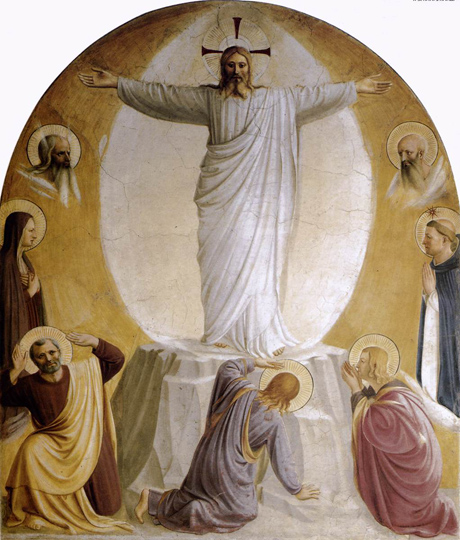
This is the fresco on the wall of Cell Six of the Convento di San Marco in Florence.
In this fresco Christ stands on a rock, prefiguring his rising from the tomb. His arms are outstretched and in this He also foreshadows his own crucifixion. He is voluminously clad in a sculptural mass of glowing white robe, and encircling Him is a radiant white mandorla. His forward gaze does not directly engage the eye of the spectator. At the base of the rock three of the Apostles crouch in awed positions, but they maintain the curious contemplative detachment from the drama of the scene which is the hallmark of this fresco cycle.
At the edge of the fresco, on either side, stand the Virgin and Saint Dominic in positions indicative of prayer, stern and unresponsive to events around them. The heads of Moses and Elias appear beneath the arms of Christ; they are introduced as detached symbols to aid meditation. There is no attempt to create any more than the bare essentials of picture space; this particular spur to devotion required no more. For Angelico, too elaborate a spatial framework as much as excessive use of color, decoration, or narrative, could detract from the picture's power.
Mocking of Christ 1440-41

This is the fresco on the wall of Cell Seven of the Convento di San Marco in Florence.
The contemplative restraint of the San Marco frescoes is nowhere better illustrated than in 'The Mocking of Christ'. Rather than paint Christ's humiliations in their full violence in a complex narrative work, they are reduced to a series of iconographic symbols. In doing this Angelico was drawing on established trecento precedents.
In a plain-walled room Christ sits on a dais in a luminous white robe and tunic. The great slab of white marble beneath Him adds to the air of radiant whiteness surrounding Him. He is blindfolded, with a crown of thorns about his head. Behind Him hanging from a plain frieze is a screen on which are painted the emblems of his indignities: the head of the spitting soldier, the hands of the buffeters, the hand and stick forcing the thorns down on his head. On a low step at the front of the picture sit the Virgin and Saint Dominic. Neither regard Christ but sit with their backs turned towards him in poses of intense meditation - the depth of meditation that the frescoes were designed to assist each friar to attain.
Resurrection of Christ and Women at the Tomb 1440-41
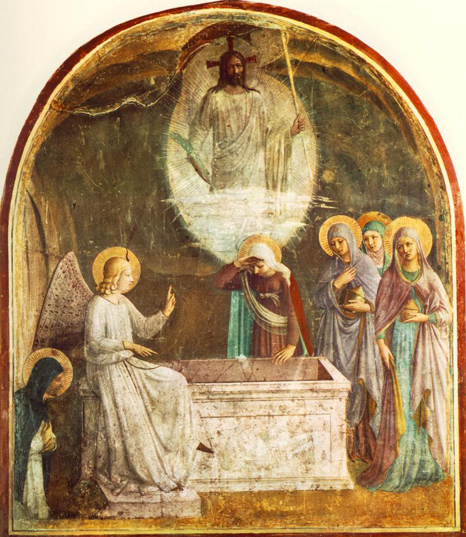
This is the fresco on the wall of Cell Eight of the Convento di San Marco in Florence.
On the left, Saint Dominic in meditation. The three women on the right were painted by Benozzo Gozzoli who at that time was an apprentice in the workshop of Fra Angelico. He collaborated in the pictorial decoration of the Dominican convent of San Marco.
Coronation of the Virgin 1440-41
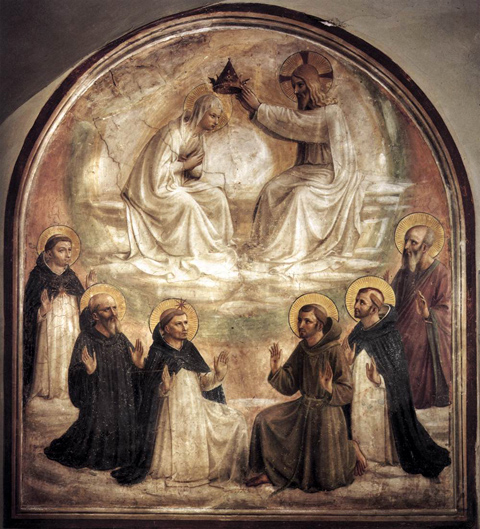
This is the fresco on the wall of Cell Nine of the Convento di San Marco in Florence.
The glory of Saint Mary, a theme dear to Angelico is acclaimed by six kneeling saints. The saints represented on the lower part are (from the left) Saint Thomas, Saint Benedict, Saint Dominic, Saint Francis, Saint Peter the Martyr and Saint Mark. The fresco probably belongs to the first ones executed in the Convent by Fra Angelico.
These six saints can be seen as a token representation of the elect, who surround Christ and the Virgin in heaven in the traditional rendering of this scene. But like so many other figures in the series of San Marco frescoes, they have an air of detachment from the events to which they are nominally witnesses. They hold their hands out in adoration and gaze heavenwards, but none looks directly at the scene of coronation. The Virgin, with her arms folded over her chest, leans forward to receive the crown. She is seated beside Christ, in accordance with the usual composition for this subject.
In this series of frescoes at San Marco Angelico has not turned back to medieval prototypes but instead, through economy in the use of figures, restraint in the overt expression of emotion, and austere use of color, he has created his own meditative images of remarkable force.
Presentation of Jesus in the Temple 1440-41
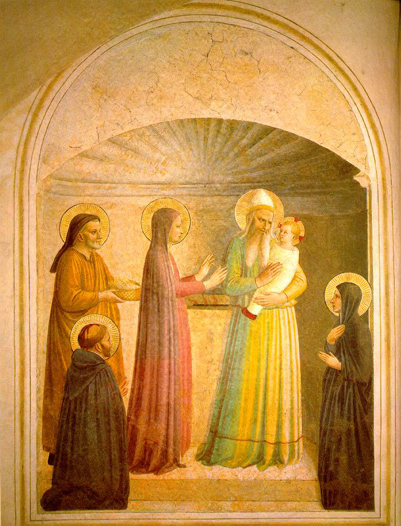
This is the fresco on the wall of Cell Ten of the Convento di San Marco in Florence: Saint Peter Martyr and the Blessed Villana of the Dominican Order contemplate the three other figures of the Evangelical story.
Along with his assistants, Fra Angelico decorated the vast convent of San Marco with frescoes. For the more public rooms, the painter produced rather festive and elaborate representations, but for the private cells where the paintings were the objects of the monks' contemplation, the frescoes were more spare and ethereal, painted with restrained color.
Adoration of the Kings 1438-46
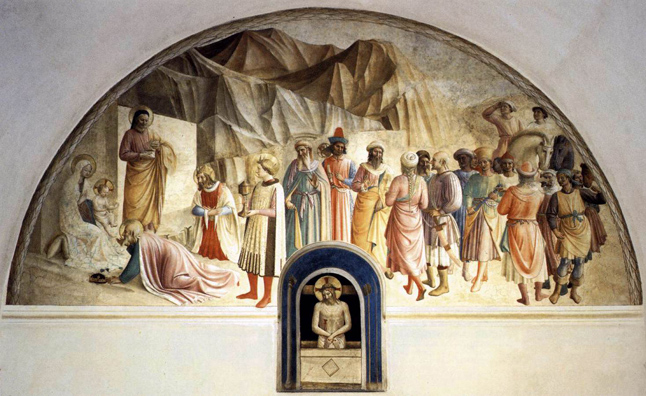
This is the fresco on the wall of Cell Thirty-nine of the Convento di San Marco in Florence. This cell was occasionally used by Cosimo de' Medici and especially richly adorned by the painter, with the collaboration of Benozzo Gozzoli.
Frescoes on the Corridors and in the Chapter Room
Quoted From: Web Gallery of Art - Fra Angelico
The Annunciation 1450
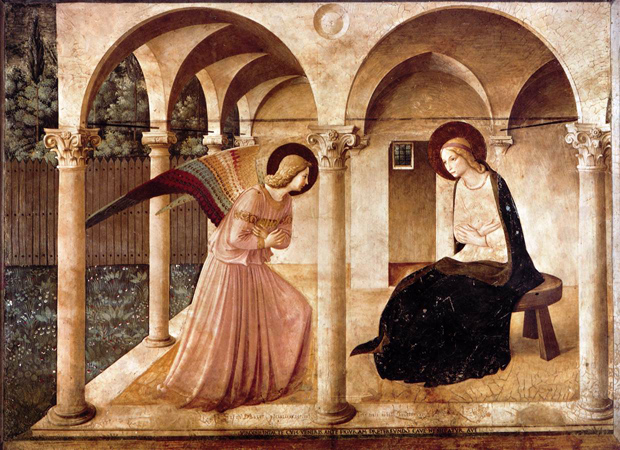
This fresco is situated on the wall of the Southern corridor on the upper floor in front of the staircase in the Convento di San Marco in Florence. It was painted on Angelico's return from Rome in 1450, and is therefore several years later than the majority of the frescoes at San Marco. In style it falls between the sparseness of The Annunciation in cell Three and the richness of the Cortona altarpiece. Unlike in the Cortona version, the garden is here viewed through a colonnade of columns which recede to a vanishing point near the centre of the painting.
Under the arches between the Corinthian columns are the slender figures of the Madonna and of the angel in devout converse, regulated with the rhythm of gentle curves; in the background, on the left, the celestial fields with Tuscan cypresses; Gabriel's wings stretch out like a rainbow. It is the theme of the tabernacles which multiply themselves at the crossing of the ways; the greeting taken from the mediaeval hymnology and the invitation addressed to the passer-by and writings under the painting show Angelico's most cultivated devotion: Salve, Mater pietatis / et totius Trinitatis / nobile triclinium / Maria!
The lighting of the scene is curiously illogical, the interior of the arcaded loggia is evenly illuminated, despite the fairly strong light coming from the left.
The Annunciation (Detail) 1450
_1450.jpg)
The detail represents the Virgin Annunciate.
Crucifixion and Saints 1441-42

The giant fresco occupies the entire wall opposite to the entrance of the Chapter Room. The Saints depicted are, from the left: Cosmas and Damian, Lawrence, Mark the Evangelist, John the Baptist, the Virgin and the pious women; to the right of the Crucifixion kneeling Dominic, Jerome, Francis, Bernard, John Gualberto and Peter the Martyr, standing Zanobi (or perhaps Ambrose), Augustin, Benedict, Romuald and Thomas of Aquino. Around the fresco, on the border, are the busts of the Prophets and Sybils in ten hexagons; in the centre, above the Crucifixion the pelican, symbol of the redemption. Below, in the lower frieze there are 17 medallions with portraits of the most illustrious members of the Dominican Order.
Crucifixion and Saints (Detail) 1441-42
_1441_42.jpg)
The detail represents Saint Benedict.
The main wall of the Chapter Room of the Convent is occupied by a large fresco showing the Crucifixion and saints. The original blue of the background has gone and the red which remains accentuates the solitary figures which stand out dramatically. The large fresco is in the form of a lunette, with life-size figures. Below, on the right there are eleven saints, one of them Saint Benedict.
_1441_42_Two.jpg)
The detail represents Saint Romuald.
Saint Dominic Adoring the Crucifixion 1440's
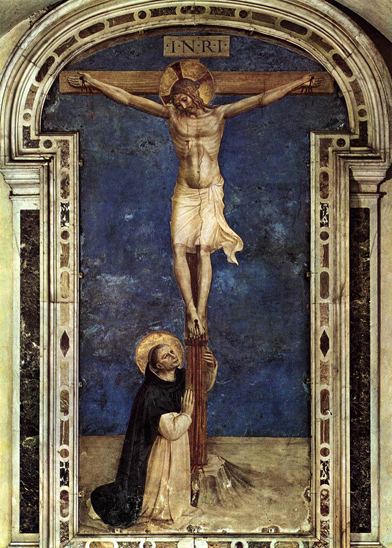
The fresco is situated in the Northern Corridor, to left of the staircase accessing the upper floor.
According to the tradition (non-documented), the face of the saint is a self-portrait.
Sacra Conversazione ca. 1450
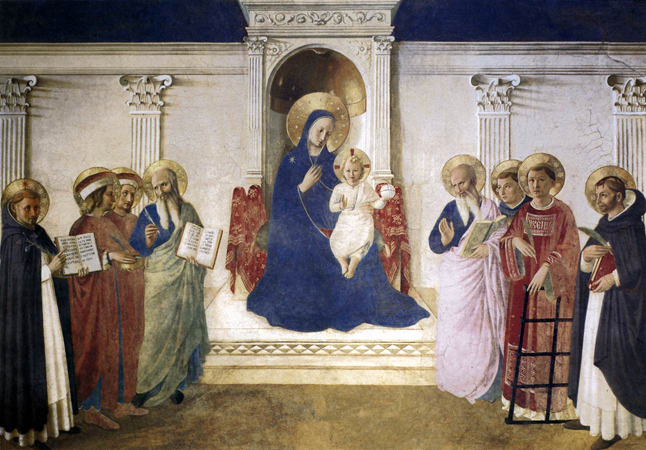
This fresco is also called 'Madonna of the Shadows' (Madonna delle Ombre).
Painted in the corridor off which the brethren's cells open (between cells 25 and 26), this fresco was one of Fra Angelico's last works in San Marco's Dominican Monastery. There is almost a metaphysical feel to the frozen gestures, the deep gazes, and the strong and boldly-applied colors. This sensation is boosted by the power of the side-lighting, which in turn is emphasized by the long shadows cast by the classical capitals. These are reminiscent of architecture by Michelozzo. This fresco is the painter's ultimate achievement of wonderful synthesis between his mystical inspiration and the effective application of recent breakthroughs in Renaissance painting.
Frescoes in the Cappella Niccolina of the Palazzi Pontifici in Vatican 1447-49
Quoted From: Web Gallery of Art - Fra Angelico
Under the pontificate of Nicholas V (1447-55) the Vatican became a court of the muses. The pope chief interest in the realm of arts was the embellishment of Rome. Fra Angelico took up his work in the Vatican for painting the pope's private chapel. The Cappella Niccolina is on the second floor of the Palazzo Vaticano (now part of the Vatican Museums). Three walls are covered with frescoes representing scenes from the lives of Saint Stephen and Saint Lawrence, two archdeacons who had been widely venerated in Rome since the early Middle Ages. The fresco on the altar wall (the south wall) had been destroyed. According to Vasari, this wall was adorned with an Entombment of Christ by Fra Angelico.
Fra Angelico was able to accomplish this considerable amount of work only with the assistance of a large workshop. In addition to Benozzo Gozzoli we know the names of other collaborators, although it is impossible to identify their individual contributions. Stylistic analysis has determined that the scenes from the life of Saint Lawrence were largely the work of Fra Angelico, while there was a greater contribution of the workshop, especially Benozzo Gozzoli, to the execution of the scenes in the lunettes.
The paintings are markedly different in emphasis from those of Angelico's in the San Marco. The purpose of these Roman frescoes was narrative, and to assist in the telling of his story Angelico used a richness of detail, multiformity of incident, number of figures and wealth of color which has no parallel in the earlier work.
View of the Chapel 1447-49

This view shows the window (west) and entry (north) walls of the chapel decorated by Fra Angelico. The fresco cycle consists of scenes from the lives of the Archdeacons Stephen (lunette) and Lawrence (bottom register).
On either side of the scenes on the west (and similarly on the east) wall there is a narrow panel containing only a single figure. These panels are actually on the inner face of the arches at the end of these walls. There eight full-length figures of saints painted on the arches. (In this view Saint Ambrose and, below him, Saint Thomas Aquinas is shown.) The chapel's wainscoting section, roughly 2.5 meters high, is painted with a wall drapery in a pomegranate design against a red background. In two spots the coat-of-arms of Pope Nicholas V appears inside a laurel wreath. The deep embrasures of the two windows present six- and seven-lobed rosettes containing alternating floral designs and portrait busts prophets and saints.
Scenes from the Lives of Saints Lawrence and Stephen 1447-49
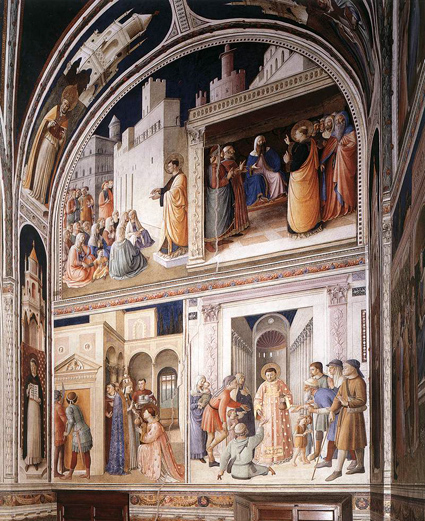
Fra Angelico was entrusted with a number of commissions for the Vatican Palace. The one that involved the most work was the decoration of the small room in the ancient tower of Pope Innocent III that Nicholas V turned into his private chapel, a rectangular space with a groin vault. The floor installed at this time survives. It displays the emblem of Nicholas V, a radiant sun. The frescoes show scenes from the lives of Saints Stephen and Lawrence, in two horizontal bands. On the rear wall was a Deposition, also by Fra Angelico and mentioned by Vasari, but now lost. On the arches are the eight Doctors of the Church in Gothic aedicules. The Evangelists are on the vault, while on the window jambs rosettes with the head of Christ alternate with heads of patriarchs and prophets.
The cycle is generally attributed to Fra Angelico and his workshop. The hand of Benozzo Gozzoli has been identified in some of the scenes from the life of Saint Stephen. Painted for the jubilee of 1450, the cycle clearly reveals the program pursued by Nicholas V of a link between Christian and classical culture. Fra Angelico's figures have a "Roman" appearance: they stand solemn and serious, like heroes from antiquity, against a background of theatrical architecture, reminding the beholder of the buildings of ancient Rome. The intention was to underline the continuity between imperial and Christian Rome which the pope wished to assert.
View of the Chapel Vaulting 1447-49
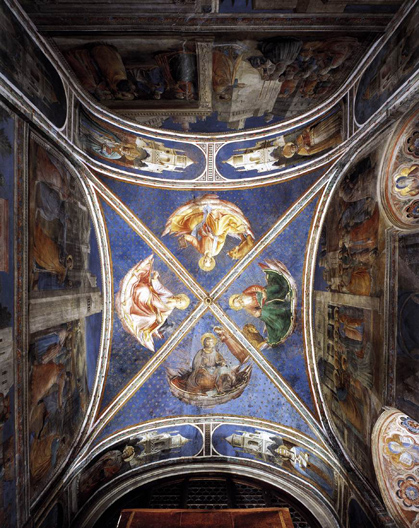
Following convention, the four evangelists appear in the ceiling's cross-ribbed vaulting against a starry sky. Drawings survive for the Saint Mark and Saint Matthew (Musée Condé, Chantilly, Fitzwilliam Museum, Cambridge), considered to be works by Benozzo Gozzoli.
Frescoes on the West Wall of the Cappella Niccolina
Quoted From: Web Gallery of Art - Fra Angelico
The walls of the chapel present the lives of the two archdeacons in two registers. The upper register, composed of three lunettes, is devoted to Saint Stephen; the lower one, with rectangular compartments, is given to Saint Lawrence, who is thus clearly given precedence. The descriptions from the career of Saint Stephen follow the Golden Legend, those of Saint Lawrence are patterned after the older cycles in his Roman tomb church of San Lorenzo fuori le Mura.
The two picture cycles begin on the west wall which also has two original window. In the lunette, Saint Peter, prince of the apostles, is anointing Saint Stephen, deacon of the church. In the smaller compartment of the lower register, between the two windows, Saint Sixtus is bestowing the same office on Saint Lawrence. This lunette also presents a second scene of Stephen distributing alms to the poor.
West Wall of the Chapel 1447-49
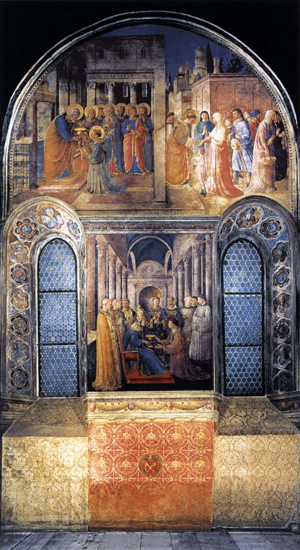
The fresco cycle consists of scenes from the lives of the Archdeacons Stephen (lunette) and Lawrence (bottom register).
On the lunette of the west wall, Saint Peter, prince of the apostles, is anointing Saint Stephen, deacon of the church. In the smaller compartment of the lower register, between the two windows, Saint Sixtus is seen bestowing the same office on Saint Lawrence. This lunette presents a second scene of Saint Stephen distributing alms to the poor. The corresponding motif from the life of Saint Lawrence appears in the right-hand picture compartment of the north wall, above the entry.
There are also two original windows on the west wall.
Lunette of the West Wall 1447-49
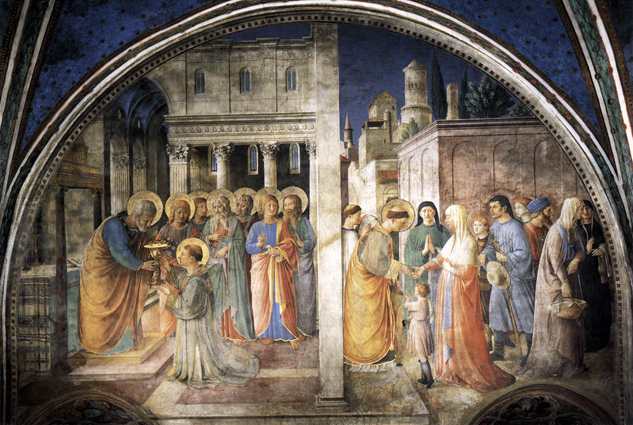
The lunette represents two scenes: Saint Peter Consecrates Stephen as Deacon; Saint Stephen Distributing Alms.
Saint Peter Consecrates Stephen as Deacon 1447-49

This scene is the left part of the lunette on the west wall.
Saint Peter Consecrates Stephen as Deacon (Detail) 1447-49
_1447_49.jpg)
Saint Stephen Distributing Alms 1447-49
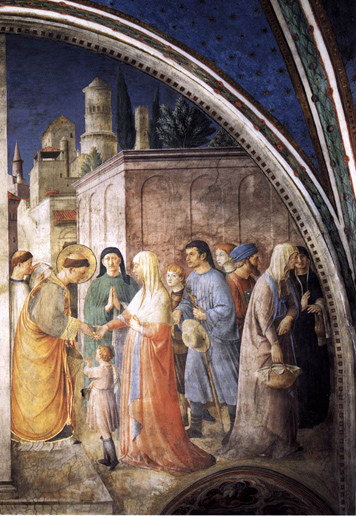
This scene is the right part of the lunette on the west wall.
Saint Stephen Distributing Alms (Detail) 1447-49
_1447_49.jpg)
Saint Peter Consecrates Saint Lawrence as Deacon 1447-49
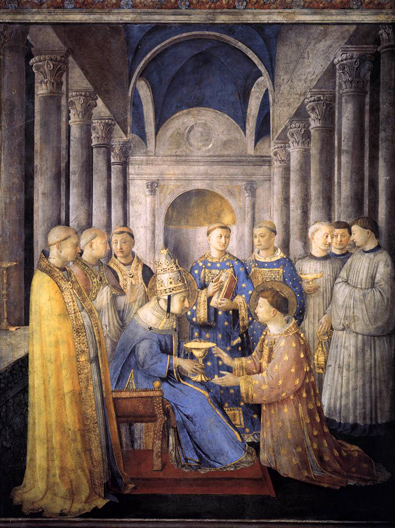
Sixtus II (257-258) had charged Archdeacon Lawrence with dispersing the church's wealth to the needy. This deed aroused the ire of Emperor Valerian who had claimed the treasure for himself, and formed the basis for the charges brought against Lawrence and his eventual execution.
In its setting in the Chapel of Pope Nicholas V in the Vatican, the dramatic impact of this fresco is aided by its position between two recessed windows. The scene is set in the nave of a basilica, the type of architectural space which in Saint Lawrence distributing Alms was used only as a backdrop. Five columns are visible on either side, and they are equaled in volume and monumentality by the bishops and other churchmen who witness Saint Lawrence kneeling before the Pope. The end wall of the basilica and its niche bring emphasis to no figure in the composition, for none stands at the centre. The central axis runs instead through the communion chalice which passes between the Pope and the Saint.
It is remarkable that in this fresco cycle the pope and the prelates wear azure vests, then rarely used and presently non-existent.
Paintings for the Armadio degli Argenti ca 1450
Quoted From: Web Gallery of Art - Fra Angelico
The series, now consisting of thirty-five panels, were commissioned by Piero de Medici for the doors of a cupboard (called Armadio degli Argenti) at the San Marco convent. The panel depicts scenes from the life of Christ.
The Vision of Ezekiel ca. 1450

This panel is part of a series, now consisting of thirty-five panels, commissioned by Piero de Medici for the doors of a cupboard at the San Marco convent, and depicting scenes from the life of Christ.
In this, the first panel, the prophet Ezekiel and Saint Gregory the Great sit in a mountainous landscape with the river Chobar running between them. In the top left of the panel is a text from the first book of Ezekiel outlining the prophet's vision, which is shown below. Ezekiel leans back, his hands raised in surprise. His vision included four animalia who, 'had one likeness: and their appearance and their work was as it were a wheel in the middle of a wheel', (Ezekiel 1, v. 16). It is this wheel within a wheel which is shown here with a flaming circumference. Angelico depicts the wheel as being made of two concentric circles. Around the larger wheel is the account of the creation from Genesis, and around the smaller the first three verses of the Gospel of Saint John, 'In the beginning was the Word, and the Word was with God, and the word was God ...', which echo the words from Genesis.
At the top right of the picture is an excerpt from the writings of Saint Gregory, who interpreted the prophet's vision and used it to emphasize parallels between the Old and New Testaments. The theme of parallels between the two Testaments is pursued through all the other panels in the series.
Paintings for the Armadio degli Argenti ca. 1450
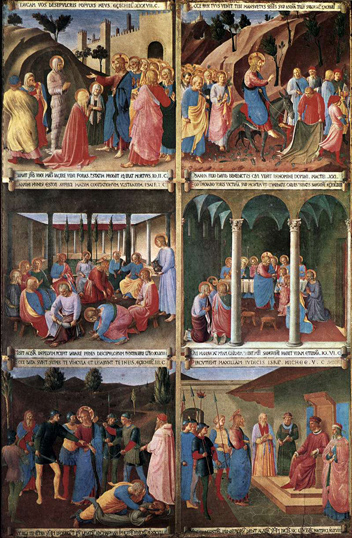
The paintings shown from the lower left side:
Resurrection of Lazarus
Entrance to Jerusalem
Washing of the Feet
Communion of the Apostles
Capture of Christ
Christ before Caiaphas
Paintings for the Armadio degli Argenti ca. 1450
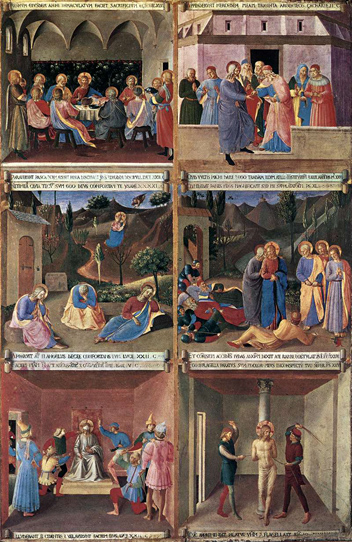
The paintings shown from the lower center:
Last Supper
Payment of Judas
Prayer in the Garden
Betrayal of Judas
Mocking of Christ
Christ at the Column
Annunciation ca. 1450
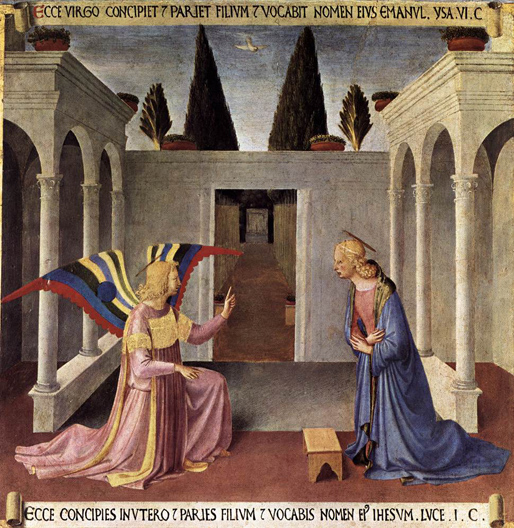
Flight into Egypt ca. 1450
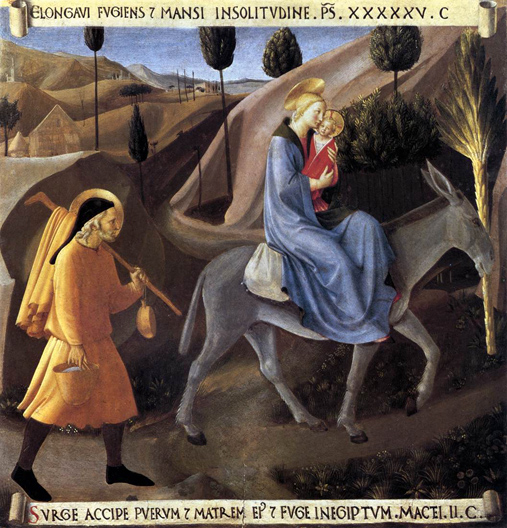
This scene shows the continuing influence on Angelico of naturalism. Having been warned in a dream, Joseph, Mary and the infant Christ make their escape from Herod's massacres by going into Egypt. Behind them a series of trees of diminishing size plots out the perspective of the landscape. The Holy Family is lit by a strong light from the left, the Virgin's draperies carefully delineated so as to show the position of both her legs as she rides side-saddle on the donkey. As in The Circumcision her halo is depicted as a three-dimensional object, which can both turn in space and reflect light. It was only late in his career as a painter that Angelico began to develop the spatial properties of the nimbus.
Massacre of the Innocents ca. 1450
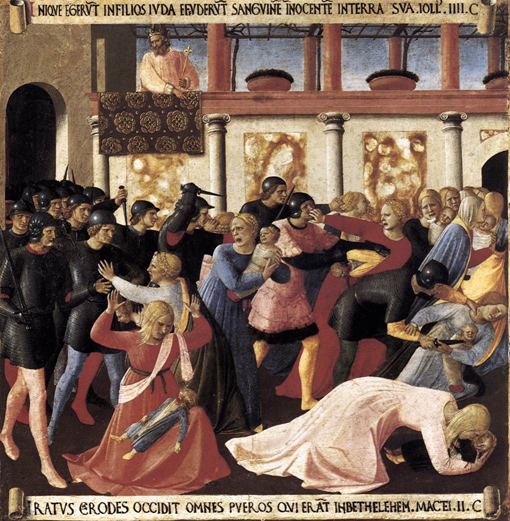
Herod, with crown and scepter, watches from above the infanticide he has ordained. The sinister, dark-clad soldiers pour through the archway wielding black daggers against the children. The mothers, shown in a great variety of terrified postures and with looks of horror, attempt to protect their infants, but to no avail.
Communion of the Apostles ca. 1450
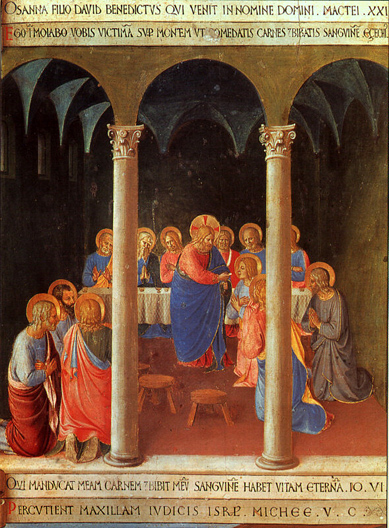
Circumcision ca. 1450
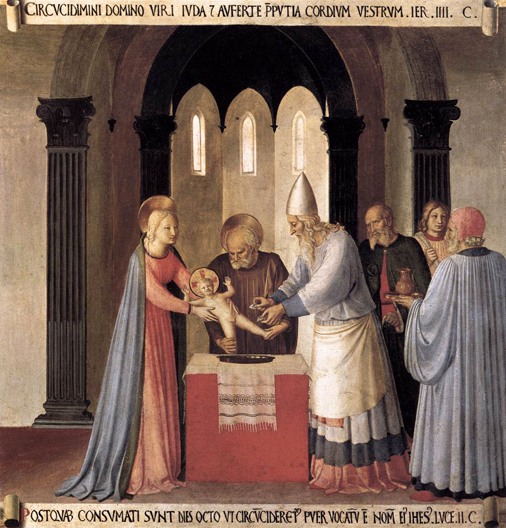
In the Temple, Christ is presented for circumcision. The table takes center stage and its receding top leads the eye back to the choir. The forms of the three figures in the foreground are echoed in the background by the three arched walls of the choir and their windows. The chiefly vertical fall of the draperies of all the figures is painted with great discrimination, and echoes the fluting of the pilasters.
Various Panels
Quoted From: Web Gallery of Art - Fra Angelico
Madonna and Child ca. 1433
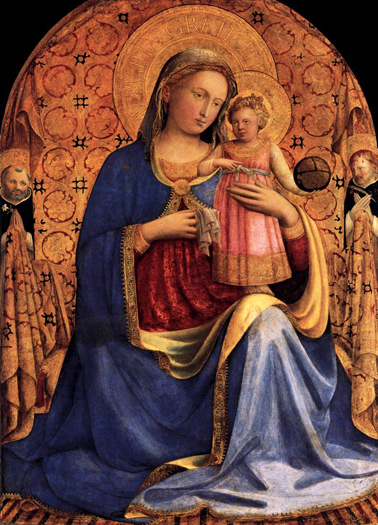
This humble image by Fra Angelico approaches the new lyricism of Ghiberti, Quercia, and Masolino. Though Fra Angelico has adopted the fourteenth-century devotional formula for his Madonna, with Mary seated close to the ground, he cannot help investing her with a richly tasseled pillow and a lavishly brocaded cloth of honor. Saints Dominic and Peter Martyr are tucked in at the left and right.
Virgin and Child Enthroned with Twelve Angels ca. 1430-33
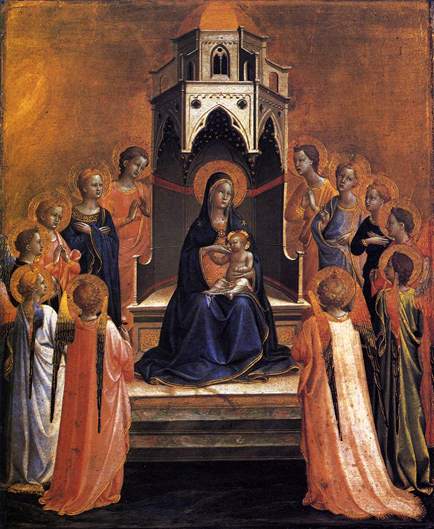
Here Angelico shows an increasing command of space and an equal interest in its depiction. He has added a carefully rendered, elegant throne raised over three steps, which fills the greater part of the panel and produces a bold spatial statement. Its top takes the form of a hexagonal cupola, but this still has chiefly pointed arches and cannot be said to represent the architectural avant-garde of the time. Compared with his later depictions of architecture it lacks monumentality. There is no attempt to extend the picture space into the far distance or to heighten the realism further, as the background of the panel is rendered in plain gold in the trecento fashion.
Virgin and Child with Saints Dominic and Catherine of Alexandria ca. 1435
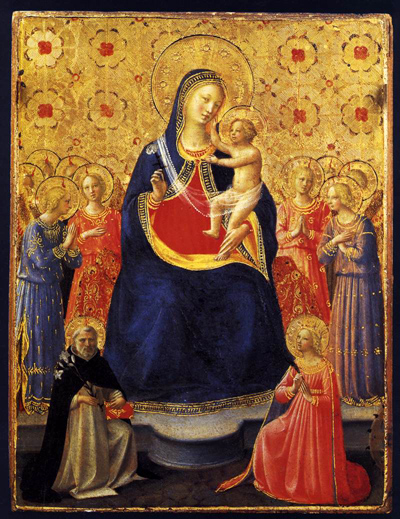
This small high quality panel shows the Virgin in glory between two groups of praying angels. She is worshipped by Saint Dominic and Saint Catherine of Alexandria, who appear on a smaller scale at the sides of the throne. T he former, wearing the Dominican habit, holds a lily in one hand, and in the other the book of the Constitutions of the Order of Preachers (Dominicans); the latter, recognizable by her attribute, the wheel, holds the martyr's palm between her hands. The holy child, standing on his mother's lap, strokes her cheek with his right hand while she holds him close, and in her free hand she holds a white rose.
Virgin and Child

The Naming of Saint John the Baptist 1434-35
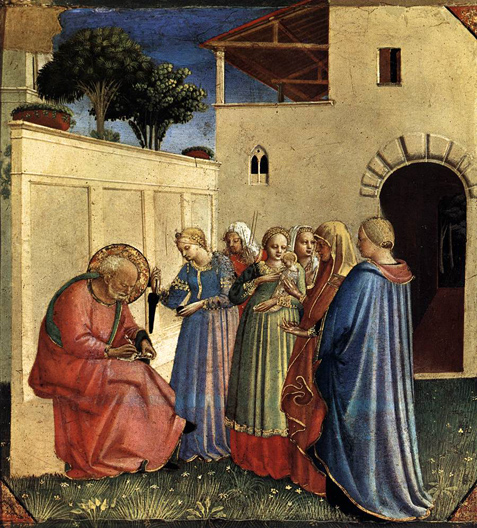
This small panel was part of a larger, unidentified altarpiece.
Saint Anthony the Abbot Tempted by a Lump of Gold ca. 1436
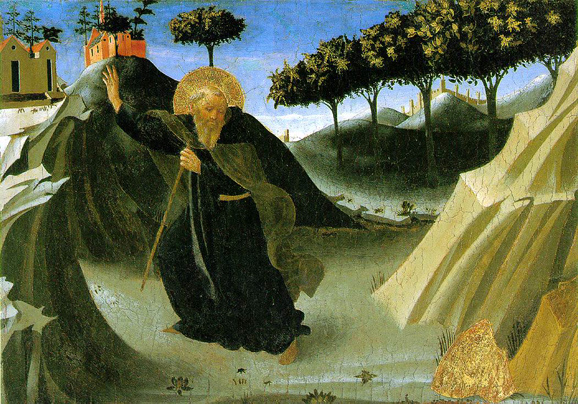
The painting is attributed by some scholars to the workshop of Fra Angelico.
Stylistically it is close to the predella pictures of the Santa Trinita altarpiece.
The Virgin of Humility 1435-45

In this painting, the image of Mary recalls the ideal of beauty promoted in International Gothic Art, although her pose and shape give her a three-dimensionality and solidity closer to the art of Masaccio. The Virgin is placed, following the traditional iconography of the Virgin of Humility, on a cushion rather than a throne.
The painting is notable for its brilliant and luminous palette, in which reds, blues and golds are harmoniously combined. Also outstanding is the sweetness and spirituality of the faces of the figures, whose poses and gestures are depicted with great naturalism.
Saint Francis Receiving the Stigmata ca. 1440

In a landscape composed of sharp-edged rocks evoking the rough countryside surrounding the hermitage at Verna, Saint Francis kneels in ecstasy before Christ in the form of an angel. From the wounds of Christ on this cross spring rays that imprint the stigmata on Francis' hands, his feet, and his side. On the right, Brother Leone, seated with his shoulders against the chapel walls, is awakened by the blinding light of the apparition.
It is assumed that this panel of unknown origin was part of a predella.
The Adoration of the Magi ca. 1445
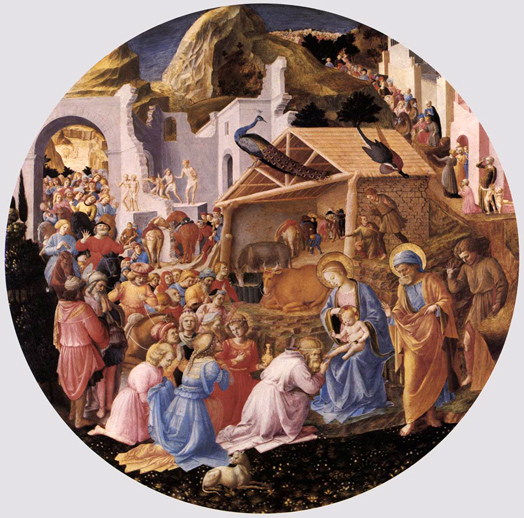
Documents indicate the this tondo may have originally belonged to Lorenzo de' Medici, ruler of Florence and patron of Renaissance artists. Following the three kings a splendid procession, symbolizing all the races of mankind, waits to pay homage to the new-born Christ. The peacock is a symbol of Resurrection. Some scholars believe that Fra Angelico laid out the composition and painted the Virgin and Child and at least some of the figures at the upper right; then his associate and fellow monk Fra Filippo Lippi completed the work.
The Adoration of the Magi (Detail) ca. 1445
_ca_1445.jpg)
This detail of the tondo by Angelico and Lippi shows the Virgin, the only one of the main figures in the work considered to be by Angelico. Comparison between her head and those of the Magus kneeling before her and Joseph to her left, reveals that they are modeled in completely different fashions.
Crucifixion 1450-55
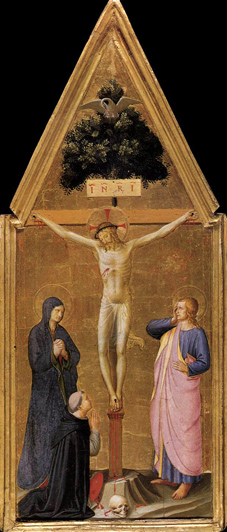
This painting was originally the central panel of a triptych. The arms of the cross stretch right across the panel, as if intended to strengthen its frame. The upper limb takes the form of a flourishing tree, a possible reference to the popular 'Legend of the True Cross' which claimed that the wood used for the crucifixion came originally from the tree of Jesse. In the branches of the tree sits a pelican in its piety, plucking its breast so that blood flows to feed its young, a common symbol of Christ giving of himself for the redemption of the world.
Cardinal Juan de Torquemada, a noted Dominican, kneels before the cross, his red cardinal's hat on the ground before him next to the rivulets of blood. On either side of the cross stand the Virgin and Saint John. The cross is in no landscape or other spatial setting. There is only an abstract gold ground behind. At the foot of the cross is a skull representing Golgotha. Its Spartan design and intense, but quietly expressed, feeling make this a powerful image reminiscent of some of Angelico's earlier frescoes in the convent of San Marco.
The Lamentation over Saint Francis 1440's
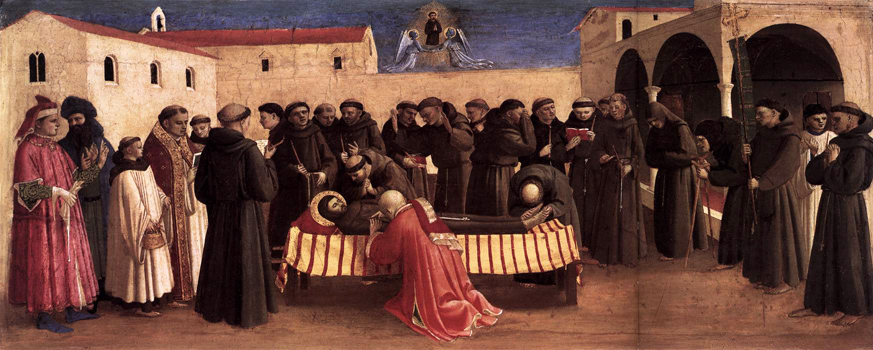
This panel was part of the predella of an altarpiece, probably painted for an altarpiece at Pontassieve. Other sections completing the predella depicting scenes from the life of Saint Francis are in Berlin (The Apparition at Arles), in the Vatican (Receiving the Stigmata), and in Altenburg (Saint Francis before the Sultan).
The Lamentation over Saint Francis (Detail) 1440's
_1440-s_Two.jpg)
The Lamentation over Saint Francis (Detail) 1440's
_1440-s_Three.jpg)
The Apparition at Arles 1440's
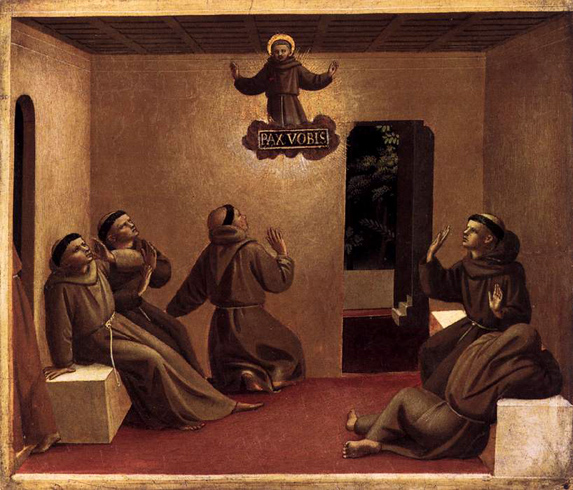
Miscellaneous Works: Illuminations, Frescoes and Drawings
Quoted From: Web Gallery of Art - Fra Angelico
Virgin and Child with Saints Dominic and Thomas Aquinas 1424-30
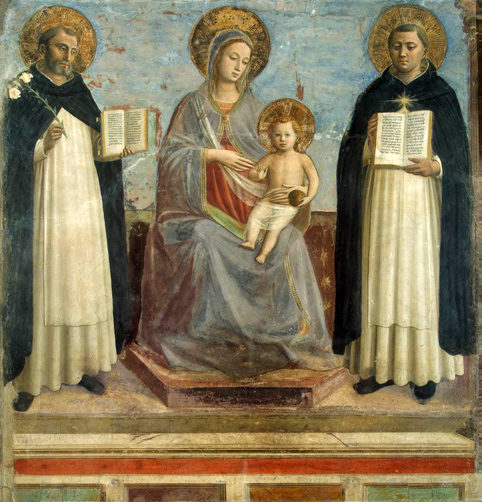
This fresco comes from the monastery of San Domenico da Fiesole, where Fra Angelico, a Dominican monk, was prior. After the monastery was closed in the 19th century this fresco was removed and sold.
The Glorification of Saint Dominic ca. 1430
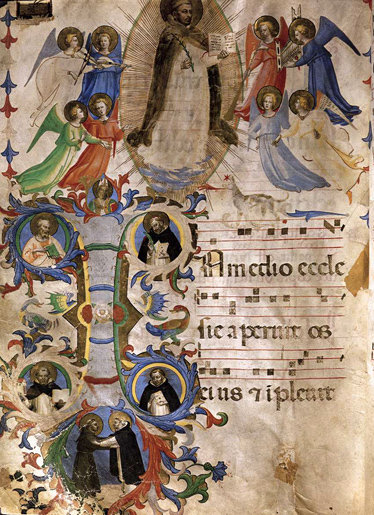
Saint Dominic, the founder of the Order of Preachers, stands within a golden mandorla (oval panel) in the habit of a Dominican, eight angels surrounding him, the four uppermost glorifying him in music. Below the mandorla to the right are the Saint's iconographic emblems: the star and the dog with a torch in its mouth, here shown as a jet of flame. The solid modeling of Saint Dominic is repeated in the sculptural qualities of the four saints who appear in the roundels sprouting out of the initial I. In the fifth roundel Saint Dominic is shown greeting his contemporary, Saint Francis of Assisi.
Conversion of Saint Paul ca. 1430
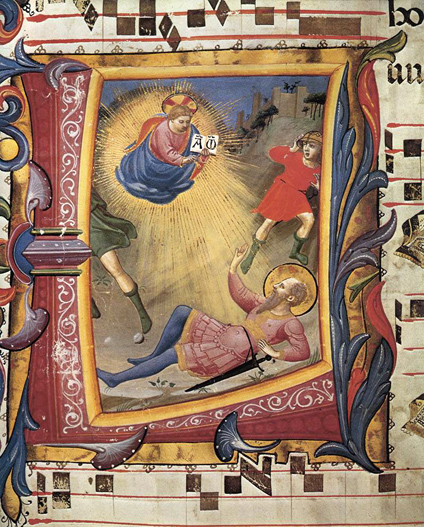
A light from heaven appears to Paul and the voice of Christ asks why He is persecuted by him. Paul is shown here lying on the ground, in a rather unrealistically relaxed pose, with Damascus, his destination, in the background represented as a town wall of simple geometric forms rendered in ambiguous perspective. A cross-shaped halo identifies the foreshortened figure in the mandorla as Christ.
Christ the Judge 1447
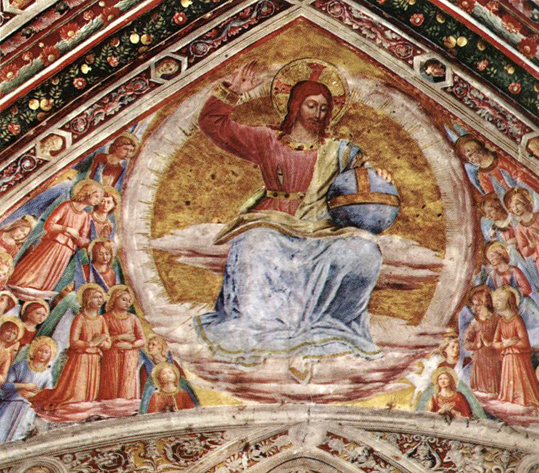
In the summer of 1447 Fra Angelico, assisted by Benozzo Gozzoli and several other minor artists, had painted a fresco of the Prophets in one of the triangular ceiling vanes and Christ the Judge in another in the Chapel of San Brizio, a large Gothic construction built around 1408 in the Orvieto Cathedral. The remaining sections of the ceiling were painted by Luca Signorelli in 1499-1500.
Prophets 1447
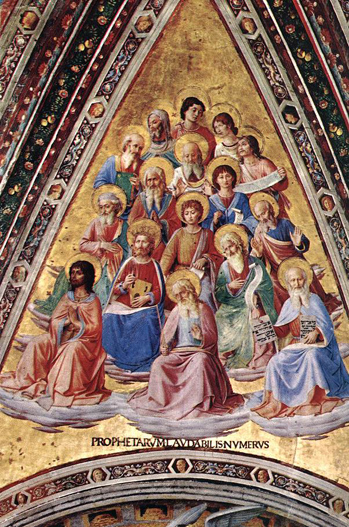
In the summer of 1447 Fra Angelico, assisted by Benozzo Gozzoli and several other minor artists, had painted a fresco of the Prophets in one of the triangular ceiling vanes and Christ the Judge in another in the Chapel of San Brizio, a large Gothic construction built around 1408 in the Orvieto Cathedral. The remaining sections of the ceiling were painted by Luca Signorelli in 1499-1500.
Crucifixion with Saint Dominic 1440-45
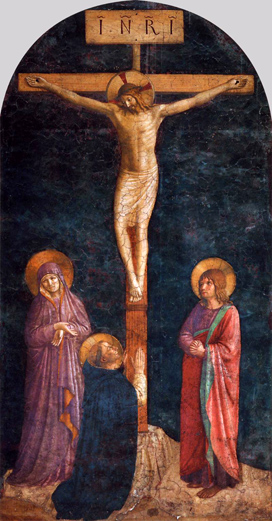
Fra Angelico painted this fresco for the refectory of the Convent of San Francesco in Fiesole. He borrowed a theme from the cloister of San Marco.
King David Playing a Psaltery ca. 1430
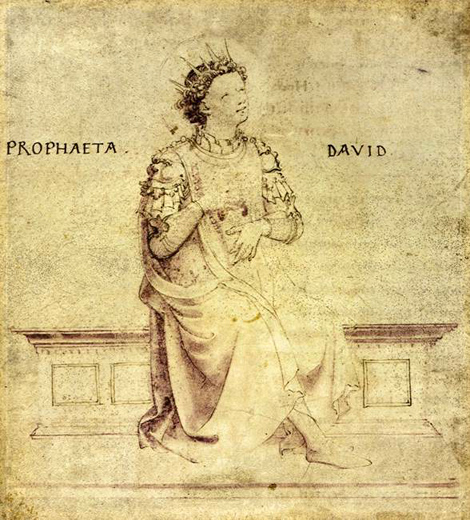
In the reformed Dominican communities such as Angelico's own, San Marco, it is known that manuscript illumination was encouraged and practiced. There is only one volume in which extensive work can safely be attributed to him, and that is the Missal number 558 at San Marco. This drawing of King David playing a Psaltery appears to be closely related in style to the work in Missal 558. David sits awkwardly, at the base of a throne on a seat, plucking at the strings of his psaltery. The depiction of the plinth, paneling, entablature and other details of the architecture on which he rests, suggests that this drawing dates from the same period as the San Marco Missal, but there can be no certainty that it was actually intended as a sketch or preparatory drawing for a manuscript illumination. The solidity and depth of parts of the draperies hint at the modeling of which Angelico was capable.
Return to Pagina Artis
Return to Bruce and Bobbie's Main Page.